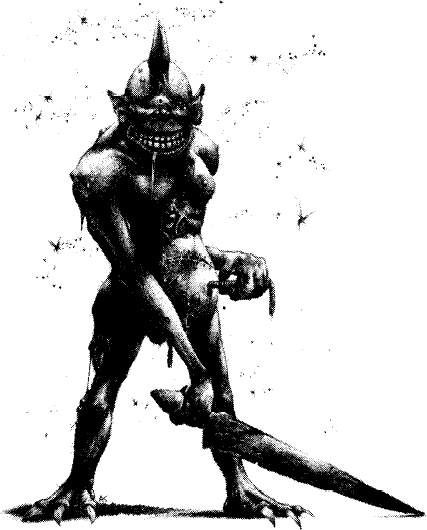
[ Models | Lore | Sources | Inspiration ]
Nurgle's Rot is arguably his most successful disease. Each victim that dies from this incurable malaise goes on to create a new Plaguebearer, and each Plaguebearer is an immortal daemon that can inflict Nurgle's Rot onto others for all of eternity.
Notable Heralds are: Abcellyoth, Aynthrexes, Epidemius, Ghulroth, and Putricifex. Other Plaguebearers include: Blackrot, Fabian, Wretch Gab'larr, Ghlub'tar, Pusmaw, Skarathaoritx, and Vommikrux.
Nurgle's Rot, or The Rot, is a strange disease. It seeks to turn its victim into one of Nurgle's Plague Bearing Demons. Unfortunately, the mortal form cannot take this tortuous metamorphosis, and must eventually perish under the strain. Only Champions and Beastmen of Nurgle are immune to its effects, serving only as carriers.
Victims gradually mutate until their characteristics are identical to those of a Plague Bearer, at the rate of 1 or 10 points (as appropriate for the affected characteristic) per month. Select the affected characteristic randomly each game month. The profile for a Plague Bearer is as follows:
| M | WS | BS | S | T | W | I | A | Dex | Ld | Int | Cl | WP | Fel |
|---|---|---|---|---|---|---|---|---|---|---|---|---|---|
| 4 | 57 | 0 | 3 | 4 | 13 | 60 | 2 | 29 | 0 | 0 | 0 | 0 | 0 |
As well as the characteristic changes, certain other physical changes take place, as follows:
| After 1 month | Skin turns pale yellow/brown |
| After 2 months | Green blotches appear |
| After 3 months | Skin begins to rot, attracting flies |
| After 4 months | A single horn begins to grow from the forehead |
| After 5 months | Horn fully grown, eyes begin to move together, nose atrophies |
| After 6 months | Eyes merge into single great eye, feet turn to three-clawed hooves |
| After 7 months | Face dissolves in a horror of melting flesh |
| After 8 months | The victim dies |
There is no known cure for this disease. It can only be contracted from a Beast of Nurgle.
Lesser Daemons of Nurgle (Aghkam'ghran'ngi)
Plaguebearers, Tainted Ones, Maggotkin, Rotbearers, Nurgle's Tallymen
Nurgle's gift to the world is Nurgle's Rot, a progressive disease combining the worse qualities of all the plagues that infest the living. It is a curse that is all the more horrible because it does not end with death, for it is a contagion of daemonic and not mortal kind, and it infests the soul as well as the body. When a mortal dies of Nurgle's Rot his soul is forfeit to Nurgle, and from that soul-stuff Nurgle fashions his Lesser Daemons the Plaguebearers. It is specifically to avoid this fate that many sufferers of the Rot undertake death quests, hoping for a clean and mortal end by this means.
The Plaguebearer carries the marks of Nurgle's Rot throughout eternity. Its skin is tinged with green or the colour of mud, running sores cover its whole body, pus and blood run continuously from its single eye, and unmentionable filth cakes its clawed hands and feet. It is the Plaguebearer's everlasting role to organise and herd the daemonic forces of Nurgle, to keep stock of the diseases, to allocate appropriate fates to each new victim, and to try and keep order amongst what is a naturally chaotic horde. Just as the living attempt in vain to impose order and meaning upon their lives, so the Plaguebearers' task is an impossible one. This is most obviously characterised by the constant counting as they try to calculate the ever changing needs and aims of their master. The Plaguebearer's voice is a deep, bass monotone. The multitude of Plaguebearers all counting at once produces a sound so sonorous and penetrating that unsecured objects will vibrate in an unholy harmony. The counting of the Plaguebearers achieves very little because it is impossible to count anything amidst such chaos; however, this in no way discourages their efforts. They are the daemonic embodiment of the need of the living to impose meaning upon a meaningless and uncaring world.
Alignment: Chaos (Nurgle).
Special Psychological Traits: Hates all Daemons and Champions of Tzeentch. Otherwise standard for Lesser Daemon.
Magic: A unit of Plaguebearers has 1 randomly determined level 1 spell for every Daemon in the unit. A normal unit of 7 will therefore have 7 spells.
Magic Items: A Plaguebearer may carry a randomly generated Chaos Weapon instead of its Plaguesword.
Special Rules: A Plaguebearer has 1 gore attack and 1 weapon attack with its Plaguesword. The Plaguebearer also receives an additional gore attack from its horn in the turn in which it charges into close combat. Horn attacks are resolved with a +2 to hit bonus.
Any living creature engaged in hand-to-hand combat against a Plaguebearer risks catching the dreaded disease Nurgle's Rot.
Plaguebearers are surrounded by a cloud of flies which buzz around them and their combat opponent. They do not affect the Plaguebearer, but they distract its foe by buzzing into his mouth, nostrils and eyes. A Plaguebearer's close combat opponent therefore suffers a -1 to hit modifier on all his attacks.
The Plaguebearer's toughened necrotic skin and mass of body-slime gives him a D6 saving throw of 6 against damage.
WFRP - the Plaguebearer has 1 armour point on all hit locations.
WFRP - the body-slime of a Plaguebearer is a deadly poison combining the effects of Manbane, Elfbane, Blackroot and Beastbane. Any opponent damaged by a Plaguebearer gore or Plaguesword attack will suffer from infected wounds.
| M | WS | BS | S | T | W | I | A | Ld | Int | Cl | WP | PV |
|---|---|---|---|---|---|---|---|---|---|---|---|---|
| 4 | 5 | 5 | 4 | 3 | 1 | 6 | 2 | 10+3 | 10+3 | 10+3 | 10+3 | 85 |
| M | WS | BS | S | T | W | I | A | Dex | Ld | Int | Cl | WP | Fel |
|---|---|---|---|---|---|---|---|---|---|---|---|---|---|
| 4 | 50 | 42 | 4 | 3 | 5 | 60 | 2 | 89 | 89 | 89 | 89 | 89 | 01 |
Nurgle's Rot, often known simply as the Rot, is a terrible contagious disease which affects the victim's mortal body and his shadow-self or spirit. A person who dies from Nurgle's Rot is turned into a Plaguebearer and becomes a servant of Nurgle himself. Nurgle's Rot epitomises the core of Nurgle's ethos: suffering and overcoming suffering by great bravery and resolve. Those who contract the Rot often slay themselves in reckless battle, hoping to die quickly and cleanly and by this means to avoid becoming a Plaguebearer.
Nurgle's Rot only affects mortals; it cannot affect Daemons of any kind or allegiance. It is passed on by physical contact such as hand-to-hand combat. Models engaged in combat against a Daemon of Nurgle risk catching the Rot. Victims can also catch the Rot as a result of a Plague Wind spell, touching a Death Head, treading in the slime-trail of a Beast, stepping into a sticky pool left by a Palanquin, or simply by being a Champion of Nurgle.
To determine if a victim has caught the Rot, roll a D6, and apply the following modifiers:
| +3 | Engaged in combat with a Great Unclean One |
| +2 | Engaged in combat with a Plaguebearer |
| -1 | If victim is the Champion of another Chaos Power |
If the result is 6 or more the victim has contracted the Rot with the following effects.
Nurgle's Rot often takes several months to kill its victim. Victims who are Champions of other Chaos Powers, or members of the retinues of these Champions, may be 'retired' from future games on the grounds that they can no longer live safely alongside their fellow men.
Retiring victims may be simply dropped from the game, or if they are Champions they can undertake a special Death Quest. In a Death Quest the Champion and any affected members of his warband will seek out and fight an enemy warband. Models engaged in a Death Quest are immune to psychology and cannot be routed. If a Death Questing Champion pleases his Chaos patron he may be promoted to Daemonhood and thus saved from the Rot.
Unless a victim retires from a warband or goes on a Death Quest as described above, he risks passing the disease on to the other members. This applies both to warbands of Nurgle's Champions and to those of Champions of other Chaos Powers. A test must be made before each battle to determine if the disease has been passed on to anyone else. On the D6 roll of a 6 the disease has been passed on to another randomly determined member of the warband. This may include the warband's Champion if he does not already have the Rot.
The Rot progresses from battle to battle, starting with the first battle following contraction. The victim slowly begins to turn into a Plaguebearer, his appearance and profile starts to change, so that eventually he dies and is re-embodied in the Realm of Chaos as a Plaguebearer.
| Battle | Effect |
|---|---|
| 1 | Skin bcomes pale yellow-brown. Change characteristic to M=4/WS=5. |
| 2 | Green and purple blotches break out on the victim's skin. BS=5/Ld=10. |
| 3 | The skin begins to rot and a small cloud of flies gathers about him. S=4/Cl=10. |
| 4 | A single horn sprouts from the victim's forehead. The model gains the Plaguebearer's additional horn attack when it charges. T=3. |
| 5 | The eyes start to grow together and the nose atrophies. I=6/Int=10. |
| 6 | The victim's feet grow into two huge claws. A=2 as per a Plaguebearer. |
| 7 | The victim's face and flesh dissolve into a mass of tissue. W=1/WP=10. |
| 8 | The victim finally dies and his shadow-self becomes one of Nurgle's Plaguebearers. |
A Champion of Nurgle who contracts Nurgle's Rot is not personally affected by it. However, he can pass it on in hand-to-hand combat and it can be caught by members of his own retinue. A member of a Chaos Warband who already has the Rot could becomes a Champion if the original Champion is slain. Should this happen the progress of the Rot is halted at the stage it has already reached.
Lesser Daemons of Nurgle (Aghkam'ghran'ngi)
Plaguebearers, Tainted Ones, Maggotkin, Rotbearers, Nurgle's Tallymen
Nurgle's gift to the world is Nurgle's Rot, a progressive disease combining the worse qualities of all the plagues that infest the living. It is a curse that is all the more horrible because it does not end with death, for it is a contagion of daemonic and not mortal kind, and it infests the soul as it does the body. When a mortal dies from Nurgle's Rot his soul is forfeit to Nurgle, and from that soul-stuff Nurgle fashions his Lesser Daemons the Plaguebearers. It is specifically to avoid this fate that many sufferers of Nurgle's Rot undertake death quests, hoping for a clean and mortal end by this means.
The Plaguebearer carries the marks of Nurgle's Rot throughout eternity. Its skin is tinged green or the colour of mud, running sores cover its whole body, pus and blood run continuously from its single eye, unmentionable filth cakes its clawed hands and feet. It is the Plaguebearer's everlasting role to organise and herd the daemonic forces of Nurgle, to keep stock of the diseases, to allocate appropriate fates to each new victim, and to try and keep order among what is a naturally chaotic horde. Just as the living attempt in vain to impose order and meaning upon their lives, so the Plaguebearers' task is an impossible one. This is characterised most obviously by the constant counting as they try to calculate the ever-changing needs and aims of their master. The Plaguebearer's voice is a deep, bass monotone. The multitude of Plaguebearers all counting at once produces a sound so sonorous and penetrating that untethered objects will vibrate in an unholy harmony. The counting of the Plaguebearers achieves very little because it is impossible to count anything amidst such chaos, though this in no way discourages them in their efforts. They are the daemonic embodiment of the need of the living to impose meaning upon a meaningless and uncaring world.
Special Psychological Traits: The Plaguebearer has standard psychology for a Lesser Daemon.
Magic: A unit of Plaguebearers has 1 randomly determined level 1 spell for every Daemon in the unit. A normal unit of 7 will therefore have 7 spells (see Magic of Nurgle).
Magic Items: A Plaguebearer may carry a randomly generated Chaos Weapon instead of its Plaguesword (see below).
Special Rules: A Plaguebearer has 1 gore attack and 1 weapon attack with its Plaguesword. The Plaguebearer also receives an additional gore attack from its horn in the turn in which it charges into close combat. All horn attacks are resolved with a +1 to hit bonus.
Any living creature suffering a wound from a Plaguesword contracts plague on the D6 roll of 1 4, 5 or 6. Determine the type of plague from the Gifts of Nurgle Table.
Plaguebearers are surrounded by a cloud of flies which buzz around them and their combat opponent. They do not affect the Plaguebearer, but they distract his foe by buzzing into his mouth, nostrils and eyes. A Plaguebearer's close combat opponent therefore suffers a -1 to hit modifier on all his attacks.
The Plaguebearer's toughened necrotic skin and mass of body-slime gives him a D6 saving throw of 6 agsinst damage. WFRP - the Plaguebearer has 1 armour point on all hit locations.
Chaos Attributes: A Plaguebearer may be given up to 7 Chaos Attributes. The daemon does not have to have the full 7, or even any, attributes - the player prefers decides the number and rolls each attribute randomly. A unit of Plaguebearers may all have the same number and type of attribute - or each Plaguebearer may be given attributes individually.
WFRP only - The body-slime of a Plaguebearer is a deadly poison combining the effects of Manbane, Elfbane, Blackroot and Beastbane. Any opponent damaged by a Plaguebearer gore or Plaguesword attack will suffer from infected wounds.
| M | WS | BS | S | T | W | I | A | Ld | Int | Cl | WP | PV |
|---|---|---|---|---|---|---|---|---|---|---|---|---|
| 4 | 5 | 5 | 4 | 3 | 1 | 6 | 2 | 10+3 | 10+3 | 10+3 | 10+3 | 85 |
| M | WS | BS | S | T | W | I | A | Dex | Ld | Int | Cl | WP | Fel |
|---|---|---|---|---|---|---|---|---|---|---|---|---|---|
| 4 | 50 | 42 | 4 | 3 | 5 | 60 | 2 | 89 | 89 | 89 | 89 | 89 | 01 |
Nurgle's Rot, often known simply as the Rot, is a terrible contagious disease which affects the victim's mortal body and his shadow-self or spirit. A person who dies from Nurgle's Rot is turned into a Plaguebearer and becomes a servant of Nurgle himself. Nurgle's Rot epitomises the core of Nurgle's ethos: suffering and overcoming suffering by great bravery and resolve. Those who contract the Rot often slay themselves in reckless battle, hoping to die quickly and cleanly and by this means to avoid becoming a Plaguebearer.
Nurgle's Rot only affects mortals; it cannot affect daemons of any kind or allegiance. It is passed on by physical contact such as hand-to-hand combat. Models engaged in combat against a Daemon of Nurgle risk catching the Rot. Victims can also catch the Rot as a result of a Plague Wind spell, touching a Death Head, treading in the slime-trail of a Beast, stepping into a sticky pool left by a Palanquin, or simply by being a Champion of Nurgle.
To determine if a victim has caught the Rot, roll a D6, and apply the following modifiers:
| +3 | Engaged in combat with a Great Unclean One |
| +2 | Engaged in combat with a Plaguebearer |
| -1 | If victim is the Champion of another Chaos Power |
If the result is 6 or more the victim has contracted the Rot with the following effects.
Nurgle's Rot often takes several months to kill its victim. Victims who are Champions of other Chaos Powers, or members of the retinues of these Champions, may be 'retired' from future games on the grounds that they can no longer live safely alongside their fellow men.
Retiring victims may be simply dropped from the game, or if they are Champions they can undertake a special Death Quest. In a Death Quest the Champion and any affected members of his warband will seek out and fight an enemy warband. Models engaged in a Death Quest are immune to psychology and cannot be routed. If a Death Questing Champion pleases his Chaos patron he may be promoted to Daemonhood and thus saved from the Rot.
Unless a victim retires from a warband or goes on a Death Quest as described above, he risks passing the disease on to the other members. This applies both to warbands of Nurgle's Champions and to those of Champions of other Chaos Powers. A test must be made before each battle to determine if the disease has been passed on to anyone else. On the D6 roll of a 6 the disease has been passed on to another randomly determined member of the warband. This may include the warband's Champion if he does not already have the Rot.
The Rot progresses from battle to battle, starting with the first battle following contraction. The victim slowly begins to turn into a Plaguebearer, his appearance and profile starts to change, so that eventually he dies and is re-embodied in the Realm of Chaos as a Plaguebearer.
| Battle | Effect |
|---|---|
| 1 | Skin bcomes pale yellow-brown. Change characteristic to M=4/WS=5. |
| 2 | Green and purple blotches break out on the victim's skin. BS=5/Ld=10. |
| 3 | The skin begins to rot and a small cloud of flies gathers about him. S=4/Cl=10. |
| 4 | A single horn sprouts from the victim's forehead. The model gains the Plaguebearer's additional horn attack when it charges. T=3. |
| 5 | The eyes start to grow together and the nose atrophies. I=6/Int=10. |
| 6 | The victim's feet grow into two huge claws. A=2 as per a Plaguebearer. |
| 7 | The victim's face and flesh dissolve into a mass of tissue. W=1/WP=10. |
| 8 | The victim finally dies and his shadow-self becomes one of Nurgle's Plaguebearers. |
A Champion of Nurgle who contracts Nurgle's Rot is not personally affected by it. However, he can pass it on in hand-to-hand combat and it can be caught by members of his own retinue. A member of a Chaos Warband who already has the Rot could becomes a Champion if the original Champion is slain. Should this happen the progress of the Rot is halted at the stage it has already reached.
Plaguebearers are created from the dying soul stuff of victims of Nurgle's greatest contagion, Nurgle's Rot. Nurgle's Rot is unusual in that it affects not only the body but the soul of the victim too. Those falling prey to its influence become Nurgle's servants. Plaguebearers are doomed to the impossible task of keping account of the innumerable plagues, contagions and infections throughout the universe, counting and recounting in a fruitless attempt to impose order on a meaningless and chaotic existence.
| Move | Save | CAF | Cost |
|---|---|---|---|
| 8/16 | 4+ | +4 | 500 |
Notes: hates followers and creatures of Tzeentch.
Plaguebearers cause panic in opponents when they charge into close combat.
Plaguebearers are surounded by clouds of flies wich swarm over their opponents in close combat, inflicting a -1 CAF modifier.
The unholy Plague Swords borne by Plaguebearers inflict an additional -1 on all Daemonic saving throws made against Plaguebearers in close combat.
Plaguebearers will use magic on occasion during battles. Each turn a detachment of Plaguebearers can use a single ability from the following list. These are cast in the appropriate fire phase for their orders unless specified otherwise.
Plaguebearer daemons are the souls of those who have died victims of Nurgle's greatest contagion - Nurgle's Rot. Nurgle's Rot is an unusual disease in that it affects not only the body but the soul of the victim too. Those infected by the Rot gradually turn into Nurgle's Plaguebearers. These daemons are doomed to the impossible task of keeping account of the innumerable plagues, contagions and infections throughout the universe, counting and recounting in a fruitless attempt to impose order on a meaningless and chaotic existence.
Plaguebearers are surrounded by a huge buzzing cloud of flies. Any enemy unit that is engaged by a unit of Plaguebearers in close combat must take a morale check (even if it is not yet broken) at the start of the close combat segment of the combat phase. If the enemy fails it is forced to go on to fall back orders and so will suffer a -2 penalty to its close assault factor. Even if the unit passes the check it still suffers a -1 close assault factor penalty due to the distracting nature of the flies. The cloud of flies does affect crewed vehicles and Ttans (the flies get in through vision slits and other small openings), but does not affect uncrewed machines such as robots and Eldar Wraithguard.
| Troop Type | Move | Saving Throw | CAF | Weapons | Range | Attack Dice | Roll to Hit | Target's Save Mod. | Notes |
|---|---|---|---|---|---|---|---|---|---|
| Plaguebearer | 10cm | 4+ | +4 | None | - | - | - | - | Cloud of flies |
| Qty | Title | Cost | MA | ST | AG | AV | Skills |
|---|---|---|---|---|---|---|---|
| 0-12 | Beastman | 60,000 | 6 | 3 | 3 | 8 | Ability: Horns |
| 0-4 | Chaos Warrior | 100,000 | 5 | 4 | 3 | 9 | None |
| 0-2 | Plague Bearer | 120,000 | 6 | 4 | 3 | 7* | Abilities: Foul Appearance, Horns |
Re-Roll counter: 70,000 gold pieces each.
* Daemons have a Daemonic Aura.
Plaguebearers are lesser Daemons which carry Nurgle's Rot to the Warhammer world from the Realm of Chaos; their Plagueswords drip with venomous slime which rots and festers in the wounds of those unlucky enough to survive an encounter with them.
It is said that the fate of those who die of the foul disease Nurgle's Rot is to serve the Lord of Decay forever in the most disgusting form of a daemon called a Plaguebearer.
Huge black flies lay their filthy eggs on these foul daemons, and clumps of maggots crawl and clamber over their putrid hides, feeding upon the putrescent matter that drips from their oozing sores. When the flies hatch, they swarm around the Plaguebearer in a buzzing cloud of vileness, and will turn upon and attack its enemies.
The Plaguebearer's body is swollen with contagion, and churning innards spill from tears in their rancid skin. It has a single baleful eye and from its head sprouts a long horn. In its clawed hand the daemon carries a sword with a distorted barbed edge. This is the Plaguesword of Nurgle whose touch brings disease and death to mortal creatures.
| Troop Type | M | WS | BS | S | T | W | I | A | Ld |
|---|---|---|---|---|---|---|---|---|---|
| Plaguebearer | 4 | 5 | 5 | 4 | 3 | 1 | 6 | 2 | 10 |
All the special rules for daemons apply as described earlier. In particular, note that the Plaguebearer has a daemonic aura which gives it a saving throw of 4+.
Fear
The foulness of the Plaguebearer overturns the mind and its indescribable stench induces nausea amd fear. The Plaguebearer causes fear as described in the Warhammer 40,000 rulebook.
Plaguesword
The Plaguesword drips with venomous slime. A wound from this weapon will kill mortal creatures outright on the D6 roll of a 4 or more, regardless of how many wounds the target can normally sustain. On a roll of 1-3 the Plaguesword only causes 1 wound. Note that this only applies to mortal foes, not to other daemons. In addition, the Plaguesword allows the Plaguebearer to parry.
Cloud of Flies
The Plaguebearer is surrounded by a black cloud of flies that feed upon his putrid skin. When the Plaguebearers are fighting these evil buzzing creatures fly into the eyes and mouths of their enemies, clogging their ears and crawling up their nostrils. Any enemy fighting a Plaguebearer must deduct -1 from his hand-to-hand combat score due to the distraction of the Plaguebearer's flies.
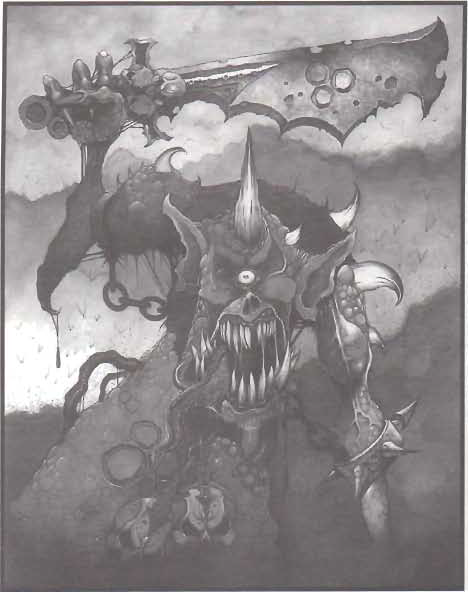

Daemons are the foot soldiers of the Chaos gods, desiring nothing other than to rip the opponents of their master apart in close combat. There are dozens of different types of Daemons, including Bloodletters, Daemonettes, Plague Bearers, Pink Horrors and others too numerous and ghastly to mention.
| Pts/model | WS | BS | S | T | W | I | A | Ld | Sv | |
|---|---|---|---|---|---|---|---|---|---|---|
| Daemon | 15 | 4 | 0 | 4 | 4 | 1 | 4 | 2 | 10 | 5+ |
Pack: Daemon packs consist of between five and ten Daemons.
Summoned: Daemons are summoned onto the battlefield as described in the special rules at the start of the Chaos army list.
Invulnerable: Daemons are unnatural creatures who have been formed from the very stuff of Chaos itself and are therefore very difficult to destroy. They are treated as being invulnerable and may make an armour save against any and all wounds that are inflicted upon them, even those that would normally pierce their armour or that allow no save to be made.
Infighting: Each different type of Daemon is the creation of one of the Chaos gods so Daemons created by different Chaos powers can not be mixed together in the same pack. Also, each type of Daemon pack has an associated special rule, which is described below.
Nurgle's Rot: After normal attacks in close combat, roll a D6 for each living model (friend or foe!) in base contact with the bearer of this gift. On a roll of 6 they contract Nurgle's Rot and suffer a single wound, with no armour save allowed. Invulnerable saves may be taken as normal. Note that this only applies to living foes, not to other Daemons, vehicles, Talos, Avatars or Wraithguard.
There is no limit to the number of rapacious warp entities eager to feast on the flesh and souls of the living. They have infinite different forms and equally infinite malice. Each of the Chaos Gods has their own favourite servants however and it is these who fill the ranks of their Daemon armies, waging eternal war for the glory of the infernal masters and their own vindictive satisfaction.
| Pts/Model | WS | BS | S | T | W | I | A | Ld | Sv | |
|---|---|---|---|---|---|---|---|---|---|---|
| Bloodletter | 26 | 4 | 0 | 5 | 4 | 1 | 4 | 2 | 10 | 3+/5+ |
| Plaguebearer | 16 | 4 | 0 | 4 | 4(5) | 1 | 4 | 2 | 8 | -/5+ |
| Horror | 17 | 2 | 3 | 4 | 3 | 2 | 2 | 1 | 8 | -/5+ |
| Daemonette | 15 | 4 | 0 | 4 | 3 | 1 | 4 | 1+1 | 8 | -/5+ |
Number/squad: 5-15
Weapons: Each type of Daemon has a range of daemonic abilities. Some of these are innate, others are conferred by the weapons they carry.
Bloodletters of Khorne fight with great warp-forged Hellblades, which function like power weapons. They are clad in the Brass Armour of Khorne and receive a 3+ armour save. They must charge and make a sweeping advance whenevr possible.
Horrors of Tzeentch use the Daemonic Fire ability to hurl sorcerous flames at their enemies. Any number of Horrors may be upgraded to Flamers of Tzeentch at +6 points per model. Flamers have the same profile but additionally have the ability to use Doombolt with no Psychic test required.
Daemonettes of Slaanesh can use the Warp Scream ability (see the Book of Slaanesh on page 59) and have Daemonic Talons.
Plaguebearers of Nurgle carry Nurgle's Rot (see Book of Nurgle) and have the Daemonic Venom ability representing the virulent slime that seeps from their knives and talons (note that the extra attack is already included in their profile above).
Summoned: Daemon packs are always summoned to the battlefield. See the Summoning specia rules for more details.
Invulnerable: Daemons are unnatural creatures, made from the very stuff of Chaos itself and are therefore very difficult to destroy. They all have the Daemonic Aura ability and have a 5+ Invulnerable save in addition to the normal armour save shown on their profile.
Instability: Daemon packs are subject to Daemonic Instability, see p. 12 for more details.
At the end of the Chaos Shooting phase, any model that is within 6" of at least one model with Nurgle's Rot may be affected by the miasma of disease and pestilence exuding from them. Roll a D6 for each affected model, and on a roll of a 6 it takes a wound. Armour and Invulnerable saves may be taken, but not cover saves. Models with the Mark of Nurgle and all Daemon Packs, Possessed, Daemon Beasts and Greater Daemons are immune.
50 Gold Crowns to hire
Plague Bearers are daemons of the Chaos god Nurgle, also known as the Lord of Decay. They can be identified by their cyclopean faces and horrifically decayed bodies. Their entrails hang from tattered holes in their grey-green, pox-ridden flesh and the aura of death and decay surrounds them. They are sometimes known as the Tallymen of Plagues or Maggotkin and are highly revered by the mortal members of the warband. As with all Daemons they can never be killed or destroyed for good so long as the power of their god prevails. However, their presence in the mortal world is tenuous and can only be maintained for long periods by Dark Magic and sacrifice. In the Carnival, the Plague Bearers revel in their showy roles as stage actors and players, dressing in filth encrusted but ostentatious doublet and hose.
| Profile | M | WS | BS | S | T | W | I | A | Ld |
|---|---|---|---|---|---|---|---|---|---|
| 4 | 4 | 3 | 4 | 4 | 1 | 4 | 2 | 10 |
Weapons/Armour: None. Plague Bearers have huge filth encrusted claws, which they use to tear and slash at their foes. They therefore neither need nor use weapons and cannot wear armour.
Cloud of Flies: Plague Bearers are surrounded by a cloud of flies, which buzz around them and their combat opponent. They do not affect the Plague Bearer but distract foes by buzzing into eyes, nostrils and mouths. A Plague Bearer's close combat opponent suffers a -1 to hit modifier on all attacks.
Stream of Corruption: Plague Bearers can spew forth a grotesque stream of maggots, entrails and filth. This is counted as a shooting attack with a range of 6" and is resolved at Strength 3 with no saves for armour.
Daemonic: Plague Bearers are Daemons of the lord of disease, Nurgle, and are not made of living flesh but the eternal and unchanging forces of Chaos. Therefore they never gain Experience.
Immune to Poison: Plague Bearers are the Daemonic embodiment of disease and pestilence. They are totally immune to all poisons and diseases.
Immune to Psychology: Plague Bearers are Daemons and do not know the concept of fear. They automatically pass any Leadership-based test they are required to take.
Cause Fear: Plague Bearers are horrifying supernatural creatures and therefore cause fear.
Daemonic Aura: Due to the magical, intangible nature of Daemons they have a special Armour save of 5+. This is modified by the Strength of the attack as normal and is completely negated by magic weapons and spells. Plague Bearers' attacks are considered as magical also.
Daemonic Instability: Plague Bearers are bound to the world by Dark Sorcery that is highly volatile and unstable. If taken out of action a Plague Bearer is banished and effectively destroyed on a D6 roll of 1-3 (do not roll for injury). In addition, if the warband routs then every Plague Bearer in the warband must take an immediate Leadership test. If this test is failed, then the Plague Bearer counts as destroyed.
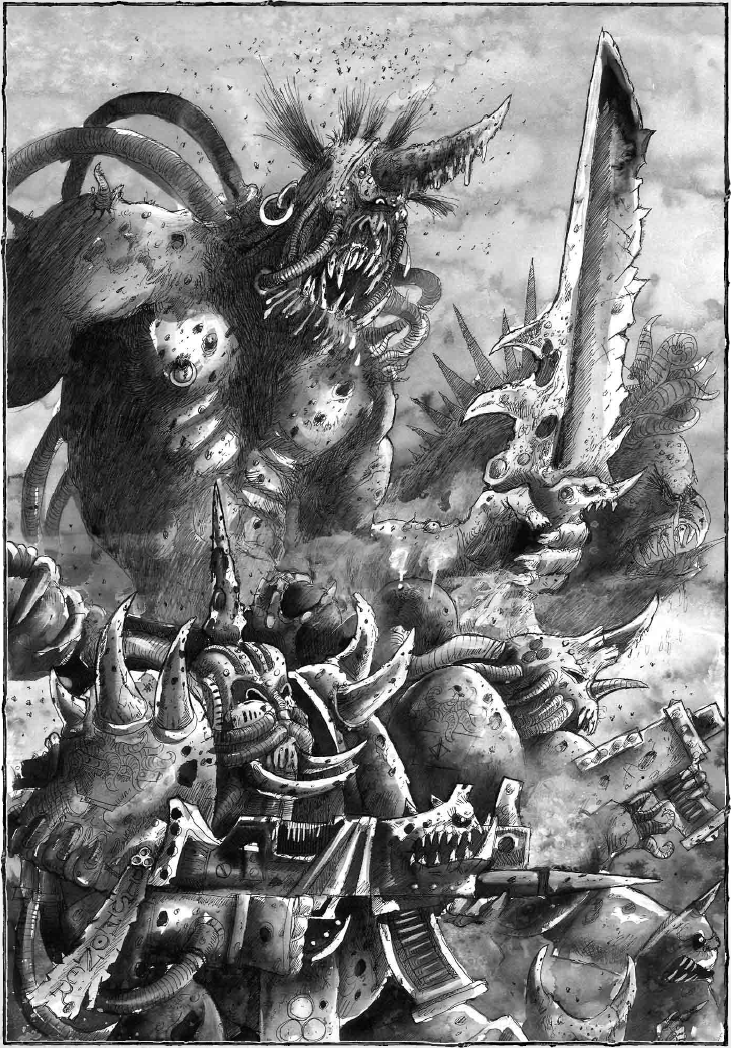
[...] the Antithesis Stone shudders and belches forth a terrifying creature of the Warp: A plaguebearer! This daemon hasn't fully been released since the Stone lacks the power to fully manifest such a creature, so it is much weaker than a plaguebearer normally would be (its Toughness is lower than normal, it has half its Wounds, and its Fearful presence is weaker).
The daemon is confused for a round and can't take action, giving the PCs a free round of attacks or to do something else. Cowardly characters might flee, but clever ones might think to use a frag grenade to deal with this horrid rock. If the PCs toss the grenade, it instantly destroys the Stone and casts the daemon back into the Immaterium. Otherwise, the characters are in for a brutal fight. Otherwise, the PCs can shoot at the stone. Three successful hits are enough to cause it to shatter and break, dismissing the daemon and ending its foul presence in this part of the Shatters.
| WS | BS | S | T | Ag | Int | Per | WP | Fel |
|---|---|---|---|---|---|---|---|---|
| 35 | 25 | 35 | 30 | 30 | 30 | 45 | 40 | 10 |
Bloated and malformed, clutching rusted butcher blades and glaring out with a single milky-white eye, these foulest of daemons are walking incubators of the most terrible diseases andcexcrescence, serving as they do Nurgle, Chaos power of decay and contagion.
Movement: 3/6/9/18
Wounds: 10
Skills: Awareness (Per), Psyniscience (WP), Speak Language (any one) (Int).
Traits: Daemonic (TB 6), Dark-Sight, Daemonic Presence, Fear, From Beyond, Infected Wounds, Natural Weapons (Teeth or Claws), Warp Instability.
Daemonic Presence: All creatures within 20 metres see phantasmal flies with human faces swarm about them, landing on and biting their flesh. As a result, they take a -10 penalty to Will Power Tests.
Infected Wounds: Any injuries inflicted by a plaguebearer automatically become infected.
Weapons: Claws and Teeth (1d10+3; Primitive).
The plaguebearer has the following traits.
Daemonic: The plaguebearer's Toughness Bonus is double against all attacks except for holy, psychic, and force weapons.
Dark-Sight: The plaguebearer can see perfectly in darkness.
Fear: All creatures that behold this daemon must take a Will Power test or flee in fear.
From Beyond: Daemons are immune to fear, pinning, insanity points, and psychic powers used to cloud, control, or delude their minds.
Warp Instability: If the plaguebearer takes damage and does not deal damage to another creatures by the end of its next turn, it must make a Will Power Test. The creature takes 1 damage for failure, plus 1 damage for every 10 points by which it failed. If this would deal damage equal to or in excess of its Wounds, it is cast back into the Warp.
Bloated and malformed, clutching rusted butcher blades and glaring out with a single milky-white eye, these foulest of Daemons are walking incubators of the most terrible diseases and excrescence, serving Nurgle, Chaos power of decay and contagion.
| WS | BS | S | T | Ag | Int | Per | WP | Fel |
|---|---|---|---|---|---|---|---|---|
| 35 | 25 | 35 | 50 | 30 | 30 | 45 | 40 | 10 |
Movement: 3/6/9/18
Wounds: 20
Skills: Awareness (Per), Psyniscience (Per), Speak Language (any one) (Int).
Talents: None.
Traits: Daemonic (TB 10), Dark Sight, Daemonic Presence†, Fear 3, From Beyond, Infected Wounds‡, Natural Weapon (Teeth or Claws), Vomit¥, Warp Instability.
†Daemonic Presence: All creatures within 20 metres take a -10 penalty to Willpower Tests.
‡Infected Wounds: Any injuries inflicted by a Plaguebearer automatically become infected.
¥Vomit: As a Half Action, a Plaguebearer can vomit on any adjacent victim. It must succeed on a Ballistic Skill Test to hit its foe. The target may Dodge the spew but may not Parry it. On a successful hit, the vomit deals 1d10+5 Damage. In lieu of Critical Damage, the vomit deals 3d10 points of Toughness Damage to the victim's Toughness Characteristic.
Weapons: Claws and teeth (1d10+3 R; Primitive, Tearing) or sword (1d10+3 R, Pen 2, Balanced, Toxic (1d10)).
Threat Rating: Malleus Minoris.
Sonorous chanting and the dull knell of bells herald the arrival of Nurgle's Plaguebearers. Surrounded by a buzzing swarm of flies, the Plaguebearers shuffle forwards, their bodies broken and twisted with morbidity. Bloated stomachs tear through paper-thin skin, showing glistening guts dripping with foetid liquids. Rheumy, cyclopean eyes stare from haggard, ravaged faces topped by a single broken horn blackened with filth. Gangling, bony limbs propel the Plaguebearers forward in a staggering lope, fuelled by the energy of decay. In their hands the Plaguebearers grasp rusted blades; Plagueswords dripping with noxious infection.
The constant humming of flies is mixed with the monotonal chants of the Lesser Daemons of Nurgle; each attempting to count the number of plagues, diseases and poxes gifted to the universe by great Nurgle. These are the Tallymen of Nurgle, eternally bound to record all of the Plague God's pestilential gifts. It is an impossible task, for Nurgle's bountiful enthusiasm knows no bounds and every day sees new strains of viruses and freshly evolved bacteria spreading across the realm of mortals. In hidden laboratories, the whispers of Nurgle's wisdom fills the minds of depraved scientists who create ever-more debilitating illnesses to inflict upon their enemies. Within rotting mounds of corpses Nurgle's eternal energy creates new fungal spores and births new breeds of necrotic bacilli.
The Plaguebearers are solemn, efficient fighters whose Plagueswords can fell the mightiest enemies with a single infected cut. Unfeeling of pain, Plaguebearers fight with a grim vigour that traps their foes in a gruelling war of attrition - a war that only the servants of the Lord of Decay can win.
Plaguebearers are formed from the energy of mortals that died from Nurgle's Rot, the Lord of Decay's most virulent and deadly blessing. The souls of those infected by this disease are slowly leeched into Nurgle's realm, appearing as warty seed pods growing from the cracked branches of gloomy willows. Each pod swells and ripens as the Nurgle's Rot destroys its host in the real world and the nascent Plaguebearer feeds upon the victim's dying energies.
These pods emit a sickly aroma whilst turning into a pustule of excreta within which writhes the growing Plaguebearer. When fully matured, the podule drops into the mulch and the newly created Plaguebearer tears himself from the leathery cocoon A mortal who resists the ravages of the Nurgle's Rot for a significant period creates an equally long incubation period for their resultant Daemon, and this will grow into a Herald of Nurgle; a larger, tougher and more disgusting individual amongst the deformed masses of the Plaguebearers.
| WS | BS | S | T | W | I | A | Ld | Sv | |
|---|---|---|---|---|---|---|---|---|---|
| Plaguebearer | 3 | 0 | 4 | 5 | 1 | 2 | 1 | 10 | 5+ |
| Herald of Nurgle | 4 | 3 | 4 | 5 | 2 | 3 | 2 | 10 | 5+ |
"All things must wither and die. Let root rot and bower blight, to feed the pestilence of abandoned hope."
— Aghalhor the Bringer of Poxes
Chief among the many gifts that Father Nurgle has granted an ungrateful galaxy is Nurgle's Rot. It is his masterpiece - completely incurable, highly infectious and with a very, very slow course. These characteristics allow it to spread uncontrollably, overwhelming whole continents, planets and star systems.
And that is not all. This perfect illness does not kill its host quickly; rather it slowly turns the victim's body into a bloated, rotting, living corpse. At the same time it erodes the victim's soul. It painfully corrupts it to the point where the tortured victim has to choose between the only two routes left open to him. He can either end his own life, or he can fully embrace the ways of Father Nurgle, predelicting in contagion and putrescence, revelling in buboes and sickness until death puts an end to his suffering.
Only then will he realise the true blessing that has been visited upon him, as his soul is reborn in Nurgle's realm, in the immortal shape of a new Plaguebearer.
Threshold: 20
Focus Time: Half Action
Sustain: No
Range: 5m
With a contemptuous flick of his hand, the sorcerer invites a plague upon his target, who then begins to vomit bile and blood as the skin forms into bulbous pustules. The disease lasts for a number of Rounds equal to 1d10 minus the target's Toughness Bonus. During each Round in which the target is diseased, all of his Characteristics are reduced by 10. Should his Toughness reach zero, the target dies.
Overbleed: For every 5 points by which the sorcerer exceeds the power's threshold, the duration of the disease increases by 1 round.
Special: If a character dies from Disease, his soul is forfeit to the plague god Nurgle. The fallen corpse will decay further and arise as a Plaguebearer (Dark Heresy Rulebook page 354) 5 Rounds later. The Plaguebearer will immediately attack anyone nearby.
The Lesser Daemons of Nurgle are shambling, pustulent creatures known as Plaguebearers. These daemons have gangling, bony limbs, their bodies swollen with decay, so much so that glistening innards are exposed through rents in their skin. They possess a single, cyclopean eye and a single horn rising above their haggard, drawn faces, their bodies covered in filth and parasites. Despite the Plaguebearers' unusual appearance, they are supernaturally resilient to harm, the gifts of their master having inured them to all pain. Plaguebearers are constantly surrounded by clouds of droning flies and chant monotonous hymns, their gait a staggering lope. Their sonorous voices attempt to keep count of the number of noxious plagues unleashed by Nurgle; an impossible task, for the Grandfather of Plagues constantly invents new strains of viruses.
Plaguebearers carry rusted, heavy blades known as plagueswords. These weapons are infused with foul infections and toxins that can make the merest scratch fatal. These daemons are solemn, cruelly efficient warriors in battle, hideously effective at any war of attrition. They also serve as the Tallymen of Nurgle, eternally bound to record all of their dark god's pestilential creations. Many believe that Plaguebearers are in fact created by such diseases, incubating within plague victims and feeding upon their dying energies, only to later fully emerge from their heaped bodies.
| WS | BS | S | T | Ag | Int | Per | WP | Fel |
|---|---|---|---|---|---|---|---|---|
| 45 | 30 | (8)43 | (15)55 | 30 | 30 | 30 | 30 | 10 |
Speed: 3/6/9/18
Wounds: 30
Skills: Awareness (Per), Psyniscience (Per), Scholastic Lore (Numerology) (Int), Speak Language (any one).
Talents: Crippling Strike, Fearless.
Traits: Daemonic (TB 10), †Daemonic Presence, Fear (2), From Beyond, Improved Natural Weapons, Natural Weapons (Claws), Regeneration (1), Strange Physiology, Unnatural Strength (x2), Unnatural Toughness (x2), Warp Instability.
†Daemonic Presence: All enemies within 10 metres of a Plaguebearer suffer a -10 penalty to Willpower Tests in the area.
Weapons: Plaguesword (1d10+13; Pen 1; Felling 1, Toxic), Claws (1d10+8; Pen 2; Toxic).
Cloud of Flies: All those within 5 metres take a -10 penalty to Weapon Skill and Ballistic Skill Tests as choking clouds of buzzing, biting flies attack every exposed inch of flesh.
Report from Watch Captain Brand
Brother Librarian,
When you asked me to share anything I knew about the enemies we regularly confront in the Reach, one incident in particular came to mind. I led a Kill-team on a mission for Inquisitor Quist, the details of which I am not at liberty to discuss. The course of our mission took us to an orbital station above a world in the Acheros Salient - we found the station to be dead in space, with only silence answering our vox-hails. My Battle-Brothers and I scoured the station starting from the uppermost decks, but we found nothing... only empty cells and eerily quiet corridors. In the lower decks our auto-senses registered movement, and my Kill-team's Apothecary warned us of rapidly increasing toxin levels. We discovered the crew of the station jammed into a relatively small chamber, their bodies bloated with pestilence, all having been slain by a particularly virulent virus. Not long after this discovery, we faced a group of daemons, each with a single rheumy eye and a black, twisted horn. These daemons were extremely difficult to destroy, and massed bolter fire was needed to take them down one by one, with the last falling to a blow from my powerfist... although it nearly seemed as if more than one swing would be necessary, for these daemons are seemingly immune to any pain or discomfort, even from missing limbs or wounds that would otherwise despatch an enemy. Eventually, we purged the station by opening that chamber to vacuum, then re-sealing it and cleansing each room with flamers.
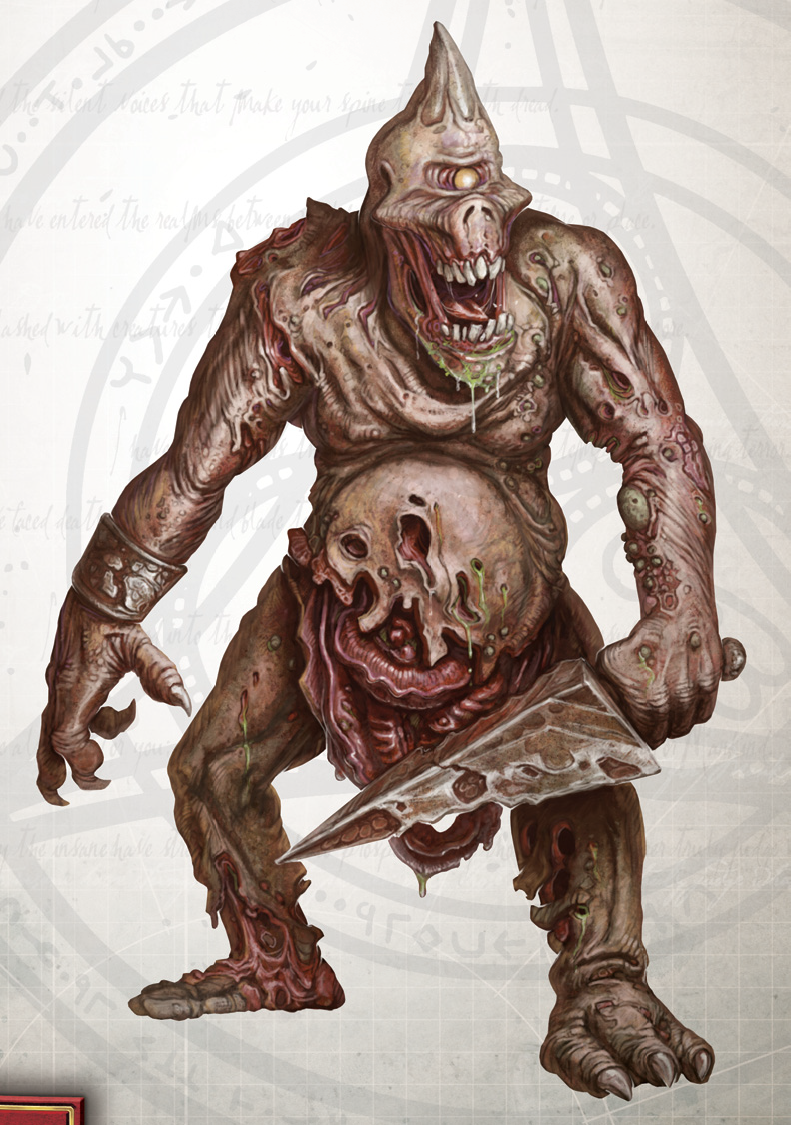
For some, the greatest terror is the failure of the mortal shell. Decay, pestilence, and rot are constants in a galaxy populated with an uncountable number of living souls. Life begets filth and plague, and in a twisted mockery of this fact, it is human life which begets the lesser daemons of the Lord of Flies. When Nurgle's ubiquitous Rot consumes the body of a human victim, the soul is likewise consumed. This process brings into being the wretched Plaguebearers. These one-eyed daemons appear as frail, wasted human bodies with bloated stomachs, long gangling arms, and broad mouths full of broken fangs and dripping with infectious spittle. Their foreheads are peaked with a single ivory horn, crusted with dried blood, mucus and pus. In their gnarled hands, they carry thick, rusty cleavers and broad slashing blades which they use on the battlefield to spread their virulent infections. Surrounded by a thick cloud of enormous black flies, they are a horrific foe, even from across the field of battle, as their host buzzes with the wings of the flies and rumbling with a dolorous dirge. The body of a Plaguebearer appears weak and fragile, but their constant exposure to the vilest concoctions of Nurgle's cauldron has made them unnaturally resilient. Inured to pain, ignorant of the idea of injury, they fight on, even laughing at the sight of their own dismemberment.
The attitude of a Plaguebearer is often more frightening to mortals than their appearance. They solemnly drudge along, steady in the suffering and despair they cause. This is not some sadistic pleasure, like that of Slaanesh, but rather a determined appreciation of Nurgle's genius, a devotion of his art and an acknowledgment of eventual disintegration of all things. Their wish to spread disease is driven by their wish to share their Father's gifts with the galaxy. As they march, they chant out the list of poxes, plagues, and pestilence their Father has created, ever certain in their growing number and increasing virulence.
| WS | BS | S | T | Ag | Int | Per | WP | Fel | Inf |
|---|---|---|---|---|---|---|---|---|---|
| 35 | 21 | 543 | 1056 | 30 | 28 | 31 | 35 | 11 | - |
Movement: 3/6/9/18
Wounds: 20
Armour: None
Total TB: 10
Skills: Awareness (Per), Psyniscience (Per), Scholastic Lore (Numerology) (Int), Speak Language (any one) (Int).
Talents: Crippling Strike.
Traits: Daemonic (+5), Dark Sight, Fear 3, From Beyond, Natural Weapons, Unnatural Strength (+1), Warp Instability.
Weapons: Claws and teeth (1d10+7 R; Primitive (6), Tearing, Toxic ) or Plague Sword (1d10+8 R, Pen 4, Balanced, Toxic [2]).
Infected Wounds: Whenever a target fails the Toxic Test from a Plaguebearer's attacks they also suffer 1d5 Toughness Damage. This takes into account the Plague Sword's rules.
Vomit: As a Half Action, a Plaguebearer can vomit on one victim within five metres. It must succeed on a Ballistic Skill Test to hit its foe. The target may Dodge the spew but may not Parry it. On a successful hit, the vomit deals 1d10+5 Damage. If the attack would deal Critical Damage, the vomit deals 2d10 points of Toughness Damage.
Daemonic Presence: All enemies within 10 metres of a Plaguebearer suffer -10 penalty to Willpower Tests.
These vile daemons of Nurgle cleave through enemies with their rusted blades, leaving plague and death in their wake.
| WS | BS | S | T | Ag | Int | Per | WP | Fel |
|---|---|---|---|---|---|---|---|---|
| 45 | 40 | (8)40 | 50 | 40 | 30 | 45 | 40 | 10 |
Movement: 4/8/12/24
Wounds: 30
Armour: Plated Hide Butcher's Apron (4 Body, 4 Legs).
Skills: Awareness (Per), Psyniscience (Per).
Talents: Blademaster, Counter Attack, Crushing Blow, Precise Blow, Sure Strike, Swift Attack.
Traits: Daemonic (2), Dark Sight, Fear (3), From Beyond, Improved Natural Weapons (Teeth), Infected Wounds†, Vomit††, Toxic, Unnatural Strength (x2), Warp Instability.
Weapons: Teeth (1d10+10 R; Tearing, Toxic), Plague Sword (1d10+12 R; Balanced, Tearing, Toxic)
†Infected Wounds: Any injuries inflicted by a Plaguebearer, whether by blade or teeth, become immediately infected. These wounds take twice as long as normal to heal naturally, and a Battle-Brother with an infected wound suffers 1d5 Toughness Damage per day until the wounds are healed. Healing Plaguebearer infected wounds requires a Very Hard (-30) Medicae Test and access to a well-stocked medicae facility.
††Vomit: As a Half Action, a Plaguebearer can vomit a thick, stinking, caustic ichor on any adjacent target with a successful Ballistic Skill Test. The vomit deals 1d10+10 points of Energy Damage.
These servants of Nurgle are devoted to spreading his corruption throughout their travels. Their exposed intestines, cyclopean eye, and horns strike fear in those who face them, while their plagueswords infect anyone they wound.
| WS | BS | S | T | Ag | Int | Per | WP | Fel |
|---|---|---|---|---|---|---|---|---|
| 45 | 30 | (8)43 | (15)55 | 30 | 30 | 30 | 30 | 10 |
Movement: 3/6/9/18
Wounds: 30
Armour: None
Total TB: 15
Skills: Awareness (Per), Psyniscience (Per), Scholastic Lore (Numerology) (Int), Speak Language (any one).
Talents: Crippling Strike.
Traits: Cloud of Flies†, Daemonic (TB 10), Daemonic Presence††, Fear (2), From Beyond, Improved Natural Weapons, Natural Weapons (Claws), Regeneration (1), Strange Physiology, Unnatural Strength (x2), Unnatural Toughness (x2), Warp Instability.
Weapons: Plaguesword (Melee; 1d10+13; Pen 1; Toxic), Claws (Melee; 1d10+8; Pen 2; Toxic).
†Cloud of Flies: All foes within metres of the Plaguebearer suffer a -10 penalty to Weapon Skill and Ballistic Skill Tests as choking clouds of buzzing, biting flies attack every exposed inch of flesh.
††Daemonic Presence: All enemies within 20 metres of a Plaguebearer suffer a -10 penalty to Willpower Tests.
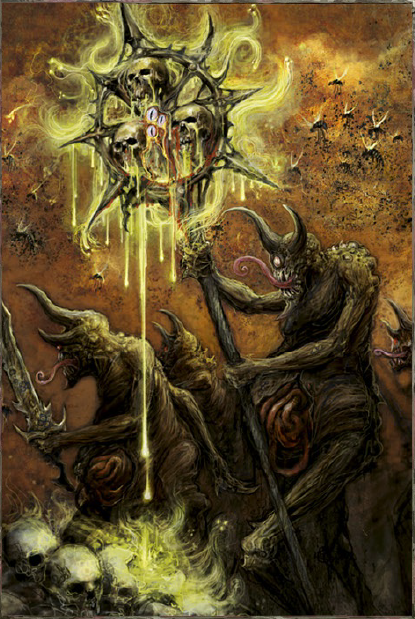
Rotten Paladins of the Plague God
The dull knell of bells and the humming of flies herald the arrival of Nurgle's Plaguebearers. Forming the rank and file of his pestilent legions, the Lesser Daemons of Nurgle shuffle forwards, their ripe bodies swollen with contagion and rife with the stench of decay. Each Daemon has a single rheumy eye and a horn sprouting from its skull - the mark of Nurgle's Rot that each bears through eternity.
It is the Plaguebearers' role to keep stock of new diseases and symptoms, and to maintain some semblance of order amongst Nurgle's naturally mischievous hordes. The Plaguebearers' obsessive need to organise is characterised by their constant counting as they try to calculate every new outbreak of plague. However, this monotonous chanting achieves very little - it is practically impossible to catalogue anything amidst the ever-changing nature of Chaos. This in no way discourages them, however, for they are the embodiment of the need to impose order upon a meaningless and uncaring world. In battle, their corpulent forms resist all but the most fearsome weaponry, and they wield rusted blades that corrupt flesh and rust metal in an instant. Unfortunately for the Plaguebearers, they are prone to losing count during combat, and they stand above their dying foes groaning in frustration before starting their count all over again.
| WS | BS | S | T | W | I | A | Ld | Sv | |
|---|---|---|---|---|---|---|---|---|---|
| Plaguebearer | 3 | 3 | 4 | 4 | 1 | 2 | 1 | 7 | - |
| Plagueridden | 3 | 3 | 4 | 4 | 1 | 2 | 2 | 7 | - |
Unit Type: Infantry. Plagueridden is Infantry (Character).
Daemonic Gifts: Plaguesword (pg 62).
Special Rules: Daemon of Nurgle (pg 26), Daemonic Instability (pg 26), Deep Strike.
A mortal who resists the ravages of Nurgle's Rot for a significant time creates an unusually long incubation period for the nascent Plaguebearer, resulting in a larger, tougher individual known as a Herald of Nurgle. Such warriors are testaments to the futility of denying Nurgle's embrace.
| WS | BS | S | T | W | I | A | Ld | Sv | |
|---|---|---|---|---|---|---|---|---|---|
| Herald of Nurgle | 5 | 5 | 5 | 5 | 2 | 4 | 3 | 8 | - |
Unit Type: Infantry (Character).
Daemonic Gifts: Plaguesword (pg 62).
Special Rules: Daemon of Nurgle (pg 26), Daemonic Instability (pg 26), Deep Strike, Independent Character.
Psyker: A Herald of Nurgle that is upgraded to be a Psyker generates his powers from the Biomancy and Plague disciplines.
Chief among the many gifts that Father Nurgle has granted an ungrateful galaxy is Nurgle's Rot. It is his most successful endeavour - incurable, highly infectious and with a very, very slow course. This perfect illness does not kill its host quickly; rather it slowly turns the victim's body into a bloated, rotting, living corpse. At the same time, it is eroding the soul, painfully corrupting the spirit to the point where the tortured victim has to choose between the only two routes left open to him: either end his own life, or fully embrace the ways of Father Nurgle, delighting in disease and putrescence, revelling in buboes and sickness until death puts an end to his suffering. Only then will he realise the true blessing that has been visited upon him, as his soul is reborn in Nurgle's realm, in the immortal shape of a new Plaguebearer.
The Rotting Riders
High-ranking Plaguebearers are known amongst the Daemon legions as Plague Drones; a title that conveys commendable humility. These overseers of Nurgle's realm ride into realspace mounted upon Rot Flies - colossal daemonic insects whose appearance is so repugnant it scars the mind. From their lofty positions, the Plague Drones can properly tally the diseases running rife across the battlefield, as well as swiftly intervene should Nurgle's divine plans meet with heavily-armed resistance.
The Rot Flies themselves are amongst Nurgle's most loathsome creations. Only the forbidden tomes of the Black Library speak of the vile process by which these creatures are birthed, for they hatch in the sticky depths of Nurgle's garden, where the visionary and the loon wander in their dreams. Some Beasts of Nurgle, disappointed by the rag-doll inactivity of their mortal playthings, develop a kernel of bitterness in their ebullient souls. Crestfallen puzzlement leads to frustration and ultimately an aching resentment. Over the millennia, a thin seed of malice grows in such a Beast's heart, feeding upon the energies of its depression and angst until it throbs like a canker.
The final straw comes when the Beast is betrayed unto death by those it wishes to call its friends. Seeking reconciliation, the Beast will put aside its doubts and bound optimistically towards the ranks of those mortals it has cornered. Should one of these ingrate warriors slay the Beast with a lucky sword thrust or well-aimed plasma blast, the creature will vanish howling into the Warp. Called back to the Immaterium, the Beast lollops and huffs, splashing down into the mire of Nurgle's garden with an aggrieved sigh. The knowledge that it cannot return to the delights of the mortal realm festers within it as it wallows in the sheer unfairness of the universe.
Over the centuries the Beast pupates, protected from harsh reality by a crawling shroud of Nurgle's fattest flies. A daemonic metamorphosis takes place as the chitinous nub of hate that lurks within the Beast grows strong on the sallow bulk of its former incarnation. Eventually, the creature within bursts out of its cocoon as a full-grown Rot Fly, a creature of pitiless malice hell-bent on wreaking its revenge upon an uncaring universe. Plaguebearers prize such steeds highly, for in their haste to punish the mortals that once spurned them, Rot Flies speed into battle at a great pace.
As the Rot Flies fall upon their prey, leathery wings buzz in a flapping purr of motion and clouds of deathbottles fill the air above, choking airborne warriors and clogging engine intakes. Prehensile probosces and posterior mouth-parts latch onto the faces of their victims, and the Rot Flies let out titters of mean-spirited laughter as they pluck heads from necks and swallow them down. When facing the common soldiery of realspace, a Rot Fly will slowly digest all meat from a skull before extruding a plague-infused death's head that its Plaguebearer rider can hurl at the foe. Given the chance, though, Rot Flies will hunt down the heroic warriors that slew their previous incarnations. A special fate is reserved for such individuals - opening their maws wider than physical law should allow, the Rot Flies swallow their prey whole, keeping them trapped in their mucus-filled abdomens for eternity.
| WS | BS | S | T | W | I | A | Ld | Sv | |
|---|---|---|---|---|---|---|---|---|---|
| Plague Drone | 3 | 3 | 4 | 5 | 3 | 2 | 3 | 7 | - |
| Plaguebringer | 3 | 3 | 4 | 5 | 3 | 2 | 4 | 7 | - |
Unit Type: Jet Pack Cavalry. Plaguebringer is Jet Pack Cavalry (Character).
Daemonic Gifts: Plaguesword (pg 62).
Special Rules: Daemon of Nurgle (pg 26), Daemonic Instability (pg 26), Deep Strike, Very Bulky.
"So many wondrous joys! So many hopes and dreams! Oh, Plaguefather, your gifts are boundless! Still, I will make an accounting of them."
— Pusmaw, Plaguebearer of Nurgle
Rotbearers, Maggotkin, Tainted Ones, Nurgle's Tallymen
Nurgle is proud of all of the plagues and poxes he has created as gifts for the mortal realm, but one disease stands out above all the rest as perhaps the favourite of the Plaguelord - Nurgle's Rot. Most of the afflictions ravage the bodies of those who become infected by them, and many even eat away at the soul of their victims, but Nurgle's Rot utterly consumes those who contract it - mind, body, and soul. It transforms them from beings of weak mortal flesh, and sees them reborn in the Garden of Nurgle as a Plaguebearer.
Once they emerge from the muck and filth of the Garden, their mortal suffering is gone, a reward for their faith in Nurgle and their acceptance of his gifts. Whatever their old body may have been, be it Imperial Guardsman, spacefaring merchant, impoverished mother of ten malnourished whelps, or leader of a Plague Cult in some rusted out underhive, their new forms are all very similar to those of the other newly-reincarnated. Their flesh is dull and covered in sores and open wounds. Pustules form and burst, their contents pouring out and collecting in the folds of the daemon's flesh. Their faces all bear a single central eye and a horn sprouts from their head. Their limbs are unnaturally gangly and yet filled with a strength the mortal likely had not felt in many years. A plaguesword, the weapon by which it will infect the enemies, and friends, of Nurgle, is given to each new Plaguebearer as a symbol of allegiance. The person they once were is no more, evolved into the physical embodiment of Nurgle's affection for his children.
Though they have left their mortal selves behind, perhaps a piece of their former existence lingers within them, for these Tallymen invariably seek to fill their days with seemingly mundane tasks, most of which involve seeking to impose some kind of order in the chaos of their new home. Many tend to his Garden, help usher other Plaguebearers into existence like midwives, or keep catalogues of the diseases Nurgle has created. Some even attempt the impossible task of keeping a tally of the ever-changing number of Nurglings that populate the Garden of Nurgle. It's all rather odd behaviour for a Daemon, when compared to the savage acts of Bloodletters or the predations of Daemonettes, but it pleases Nurgle to see his children doing as they wish, and a father's love for his children is best left simply admired, if not understood.
Prime Corruptors, The Plagueridden, The Resolute
Those who receive the blessing of Nurgle's Rot endure some of the most twisted and foul bodily depredation imaginable. Sores swell, pulse, and split open, spraying pus and maggots. Bruises appear in an instant from even the slightest contact, often times with no contact at all, turning the flesh purple, yellow, and black. Fingers, toes, ears, and lips rot away and fall off. Hip bones soften and break, forcing leg bones through rancid flesh. In particularly vicious cases, the eyes and tongue become fertile breeding grounds of flies or even an especially mischievous Nurgling or two. It is a misery to which no amount of description can ever possibly do justice.
The toll it takes reaches beyond the physical form and into the minds and souls of the mortals who contract it. Still, dedicated followers of Nurgle understand that even this suffering is a gift from their master. Most bear the decay for as long as they can, cherishing each day of life and appreciating their place in the great cycle. There are those, however, who abandon all that Grandfather Nurgle has given them. They opt for a self-inflicted and untimely death rather than suffer with their malady as they promised they would. These wretches are forgotten. Cast aside by a disappointed lord, they dissolve into nothing, their flesh and souls utterly consumed.
There is a third path open to the strong and resolute believers. Resistance to Nurgle's Rot is always impossible in the end, but for these devoted mortals, the end can be forestalled. As their bodies collapse further and further into ruin, a peaceful calm comes over their minds and settles into their souls. At last, immobile heaps of little more than quivering flesh and rotted entrails, even these mortals succumb. When they are reborn in the Garden, their Plaguebearer form is more massive, stronger, and more powerful than those who could not resist the Rot as they did. These Plaguebearers reap one of Nurgle's greatest rewards, leading and inspiring their lesser brethren as Heralds of Nurgle.
"How many are there, Vommikrux?" asked the young Plaguebearer.
"Silence, pustule. I'm counting," replied the elder Daemon as he set a rotting head in the pile to his left.
"It's Blackrot, old stinky, and I know. That's what I asked. What's our count so far?"
Blackrot's enthusiasm was welcome most of the time, but at present it was distracting to the old Plaguebearer. Vommikrux had been sorting the head piles for longer than he could remember. It was the first task he'd been given when he took form as a Plaguebearer, and he would not be allowed to move on to another until he finished it. He had counted the heads more than a thousand times since the first, never coming up with the same number and therefore never knowing if he was accurate. Now he had the end in sight. No troublesome Nurglings had stolen any heads from the pile, nor had a fresh crop sprung up in the Garden. Just a few more and he could complete his task. He just needed Blackrot to calm down and let him finish. Twelve thousand and sixteen, twelve thousand and seventeen...
Blackrot grabbed Vommikrux's elbow, tugged it slightly and peered over his elder's shoulder at the head in his hand. "Is that twelve thousand and fifteen, or twelve thousand and sixteen?"
"It's twelve thousand and sixteen, or wait, maybe it's nineteen. I... I don't know! Tzeentch take you, Blackrot, I don't know! You've made me lose count. Now I have to start over. Not again..."
Blackrot jumped up and grabbed a head from the pile. "It's alright, stinky," he said with a rotting smile, "I'll help!"
Plague Cults often summon Plaguebearers to help them in the spreading of disease and corruption. Obsessed with counting and cataloguing every contagion ever created, Plaguebearers welcome any chance to push through to the mortal realm.
Requirements: The ritual must take place in an area touched by disease and the stench of death, and requires a roughly carved circle marked with icons devoted to Nurgle while cauldrons of putrid bubbling liquids fill the entire area with a horrid stench. Rotting corpses - they needn't be human - should form a pile at the centre. A single adult human, their body untouched by disease or illness, should sit atop the pile of corpses, ready to absorb all the filth and become the window through which the Plaguebearer emerges. The ritual requires a Hard (-20) Forbidden Lore (Daemonology) Test, modified per Table 6-7: Summoning Ritual Modifiers (see page 229 of the Black Crusade Core Rulebook). If successful, then the Heretic must make a Daemonic Mastery Test to control the Plaguebearer.
Effects: A Plaguebearer (see page 355-356 of the Black Crusade Core Rulebook) appears in the summoning circle.
Duration: The Plaguebearer remains corporeal for 1d5+5 rounds, plus an additional round for every additional Degree of Success on the Test. Areas where the veil between reality and the Warp is thin might extend this duration. Heretics may summon the Daemon for a specific task (at the GM's discretion), in which case it remains corporeal long enough to accomplish the task.
Cost: Whether successful or not, the Heretic must roll on Table 6-2: Psychic Phenomena (see page 210 of the Black Crusade Core Rulebook) and immediately apply the results. Additionally, each character involved in the ritual must pass a Challenging (+0) Toughness Test or gain 1d5 levels of Fatigue, doubling over and choking on the waves of smog and clouds of flies that accompany the Daemon's arrival.
The Price of Failure: Failure results in a roll for Contempt of the Warp (see page 227 of the Black Crusade Core Rulebook), modified by +10 for every Degree of Failure beyond the first.
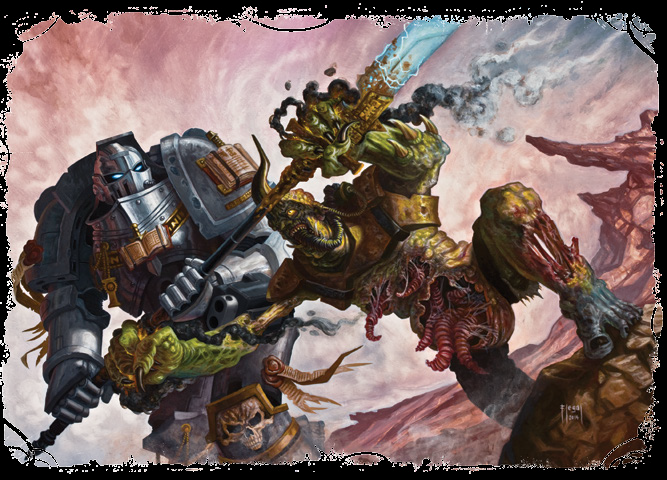
The cavalry of Nurgle are one of the fleetest and most dangerous assets of the Great Corruptor's forces. When the call to battle is given, high ranking Plaguebearers and affliction-indulgent Rot Flies undergo a mutual infection that binds their bodies together. They undergo this transformation simultaneously, sharing an intuitive rider-mount persona while gaining additional abilities and protections. They zip through armed conflicts, slashing down foes with Plague Swords while showering the battlefield in disease and pestilence with vile fluids ejected from putrid proboscises.
| WS | BS | S | T | Ag | Int | Per | WP | Fel | Inf |
|---|---|---|---|---|---|---|---|---|---|
| 43 | 43 | 743 | 1252 | 61 | 34 | 43 | 43 | 25 | 07 |
Movement: 6/12/18/36
Wounds: 40
Armour: None
Total TB: 12
Skills: Awareness (Per) +20, Dodge +20, Psyniscience (Per) +10, Scholastic Lore (Numerology) (Int), Speak Language (Any One, Miren) (Int).
Talents: Crippling Strike.
Traits: Daemonic (5), Dark Sight, Fear (4), Flyer (6), From Beyond, Natural Weapons, Toxic (4), Unnatural Strength (3), Unnatural Toughness (2), Warp Instability.
Weapons: Plague Sword (1d10+11 R; Pen 4; Balanced, Toxic [4]), Pestilent Proboscis (Ranged; 30m; S/-/-; 1d10+4 I; Pen 2; Pestilent Slime†, Toxic [4]).
Infected Wounds: Whenever a target fails the Toughness Test from the Toxic Quality of a Plague Drone's attack, the target also suffers 1d5 Toughness Damage.
†Pestilent Slime: When the Plague Drone inflicts Damage (after reductions for armour and Toughness Bonus) with this weapon, the target also suffers 1d10 Toughness Damage.
Daemonic Presence: All enemies within 30 metres of a Plague Drone suffer a -20 penalty to Willpower Tests.
While the Miren swarms bubbling up from the surface might be tainted by the Warp and have vile ichor pumping through their stinking veins, other occupants of the surface of Mire are entirely of the Beyond. As such, the servants of Nurgle are wont to appear as if from nowhere, fading into existence according to the fickle tides of the Warp and the waxing and waning of their patrons power. Unlike manifestations in the material universe, on Mire, deep as it is in the Inner Ring of the Screaming Vortex, Daemons do not require a mortal host to possess in order to appear and may do so according to their own, unknowable whims.
As the Heretics press on, they encounter one or more Plaguebearers of Nurgle, as described on page 355-356 of the Black Crusade Core Rulebook. To set the scene, read or paraphrase the following aloud:
Marching ever onwards through the acid green fog, you grow aware of a low, sonorous chanting emanating from somewhere up ahead. The sound grows louder as you approach, until at length you begin to discern individual words. Each is name, a word of power spoken in one of the many tongues of the dwellers in the Warp. You may or may not know the exact meaning of each name, but the intent is clear, for at the sound of each, a wave of sickness passes through you, each subtly different from the last. It soon becomes clear that the words are the names of the myriad blessings of the Plague God, and they are being spoken by one of his servants, the so-called "tallymen": a Plaguebearer.
As you approach still further, you come upon the Daemon. It is a mound of decay, its form vaguely humanoid but its green flesh sloughing from it. Its head bears a single eye and one twisted horn, and its leering mouth is recanting the names of its master's blessings with such joy that it grins and drools with each new utterance. At length, the Plaguebearer senses your approach, and slows its chant before falling silent.
"Speak, mortals," it says, "Or depart my master's domain."
Exactly how the Heretics react to the ominous appearance of the Plaguebearer is up to the players. Those dedicated to Ruinous Powers other than Nurgle might be driven to attack it, while others might prefer to avoid contact entirely. Heretics possessed of the blessings of the Plague God might attempt to communicate with the Daemon in some manner and to some end, or even to turn it to their service, for a time at least. The details are left to the players to concoct and the Game Master to accommodate, or not, accordingly.
As with many of the other encounters presented in this part of the adventure, the Game Master can use this one more than once should he wish. He can modify it further by having more than one Plaguebearer present, especially if the Heretics determine to fight it or provoke it.
The psyker focuses his mind on the generosity of Grandfather Nurgle, drawing forth from the Warp a great gift of disease to share with those around him. A noxious and unnatural slime splashes across all those nearby, infecting them with the galaxy's most perfect disease.
Action: Half Action
Focus Power: Difficult (-10) Willpower test
Range: 2 metres x Psy Rating
Sustained: No
Subtype: Attack
Effect: Each character within range (excluding Daemons of Nurgle and those sufficiently devoted to the Plague God) must make a Toughness test. Each target that fails the test immediately suffers 2 x PR Strength damage and 2 x PR Toughness damage. If this results in a character's death, the character is reborn after 2d5 rounds as a loathsome Plaguebearer (see page 415).
Nurgle's foul foot-soldiers are the Plaguebearers, Warp-spawned embodiments of disease and decay. These rotten paladins solemnly serve the Heralds and other higher-order Daemons of Nurgle both in the Realm of Chaos and when the Plague God's forces erupt forth into reality. On those momentous occasions when their plans burst forth like maggots from rotten meat, the Callers of Sorrow summon Plaguebearers to accompany their assaults on Hive Desoleum as shock troops, or to act as guardians when the hive's defenders seek retribution.
The mere sight of a Plaguebearer is more than enough to induce overwhelming madness and physical illness, for they represent the greatest fears and most visceral disgusts of humanity. Most feature stained horns and a single, rheumy eye, while their decay afflicts each in a unique manner. Their putrefying flesh and spilling innards are impossibly revolting, further amplified by the unnatural aura surrounding all creatures of the Warp. As they advance, the Plaguebearers sonorously chant, counting the innumerable diseases that Nurgle has gifted to the galaxy, forming a maddening drone like the buzzing of countless flies.
It is written that Plaguebearers are formed from the souls of mortals who succumbed to Nurgle's Rot; as the victim's living body decays in the physical world, so does the soul rot in the Warp, slowly birthing a Daemon to serve the Plague God. Thus does a mortal who receives Nurgle's greatest gift spend the rest of eternity repaying the debt.
| WS | BS | S | T | Ag | Int | Per | WP | Fel | Ifl |
|---|---|---|---|---|---|---|---|---|---|
| 52 | 32 | 486 | 5110 | 36 | 37 | 47 | 496 | 01 | - |
Wounds: 20
Armour: Head 13, Arms 14, Body 14, Legs 14
Movement: 3/6/9/18
Threat: 17
Vomit Attack: Class Pistol, Rng 5m, RoF S/-/-, Dmg 1d10+2 (E), Pen 2, Clip -, Rld -, Wt -, Avl -, Corrosive, Spray, Toxic (2)
Plague Sword: Class Melee, Rng -, RoF -, Dmg 1d10+137+SB (R), Pen 0, Clip -, Rld -, Wt 7kg, Avl UN, Toxic (2)
Skills: Athletics (S) +30
Talents: Iron Jaw, True Grit
Traits: Baneful Presence (10), Daemonic (2), Deadly Natural Weapons, Fear (2), From Beyond, Nauseating (see sidebar), Unnatural Strength (2), Unnatural Toughness (3), Unnatural Willpower (2), Warp Instability
Gear: Rot armour
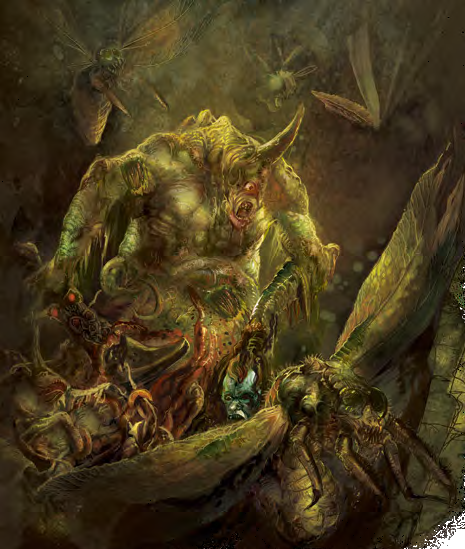
The psyker focuses his mind on the generosity of Grandfather Nurgle, drawing forth from the Warp a great gift of disease to share with those around him. A noxious and unnatural slime splashes across all those nearby, infecting them with the galaxy's most perfect malady.
Action: Half Action
Focus Power: Difficult (-10) Willpower test
Range: 2 metres x Psy Rating
Sustained: No
Subtype: Attack
Effect: All characters within range (excluding Daemons of Nurgle and those sufficiently devoted to the Plague God) must make a Toughness test. Each target that fails the test immediately suffers 2 x PR Strength damage and 2 x PR Toughness damage. If this results in a character's death, the character is reborn after 2d5 rounds as a Plaguebearer.
Not all Beasts overcome their playthings, and some are even banished back to Nurgle's Garden where many years might pass as they develop new forms, protected by thousands of bloated flies. They emerge as Rot Flies - their joy gone, replaced by hatred and a need for revenge. Their form also changes: legs are replaced by sharpened limbs, slimy flesh hardens into armoured chitin, and tentacles are replaced with enormous, insectoid wings.
The Pus Lord cannot bear to see such madness take root in one of his children, so he sends elite Plaguebearers known as Plague Drones to care for these Daemons. Riding airborne atop their Rot Fly steeds, Plague Drones eagerly spread disease and decay at the forefront of Nurgle's children. Though few have been sighted in Askellon, or at least few have survived to report such occurrences, Poxifex Spengh of the Callers of Sorrow has performed many ritual supplications to his Grandfather for aid in summoning these foul creatures to his side.
| WS | BS | S | T | Ag | Int | Per | WP | Fel | Ifl |
|---|---|---|---|---|---|---|---|---|---|
| 54 | 22 | 426 | 7213 | 40 | 30 | 30 | 496 | 14 | - |
Wounds: 20
Armour: Head 16, Arms 17, Body 17, Legs 17
Movement: 6/12/18/36
Threat: 18
Plague Sword: Class Melee, Rng -, RoF -, Dmg 1d10+137+SB (R), Pen 0, Clip -, Rld -, Wt 7kg, Avl UN, Toxic (2)
Skills: Athletics (S) +20
Talents: Iron Jaw, True Grit
Traits: Baneful Presence (20), Daemonic (3), Dark-sight, Fear (2), Flyer (6), From Beyond, Nauseating, Size (5), Unnatural Strength (2), Unnatural Toughness (3), Unnatural Willpower (2), Warp Instability
Gear: Rot Armour
Drone Gulp: When fighting an opponent of Size (4) or less in melee combat, should the Plague Drone score more degrees of success than the Weapon Skill bonus of its foe, the Daemon immediately swallows the target whole. The target immediately suffers a result of 1d5 on Table 7-16: Impact Critical Effects - Body on page 238 of the Dark Heresy Core Rulebook. Breaking out requires a Hard (-20) Strength test, or some other challenge at the GM's discretion. Failure on a test to escape means the character immediately suffers a result of 1d5 on Table 7-8: Energy Critical Effects - Body on page 234 of the Dark Heresy Core Rulebook.
Mortals who manage to resist Nurgle's Rot for a lengthy time become powerful Plaguebearers, which are known as Heralds of Nurgle. These nightmarish creatures embrace their role and lead their daemonic brethren from the Garden of Nurgle to the mortal realms of man.
| WS | BS | S | T | Ag | Int | Per | WP | Fel | Ifl |
|---|---|---|---|---|---|---|---|---|---|
| 55 | 41 | 568 | 6916 | 30 | 48 | 50 | 618 | 21 | 45 |
Wounds: 33
Armour: Head 19, Arms 20, Body 20, Legs 20
Movement: 4/8/12/24
Threat: 31
Vomit Attack: Class Pistol, Rng 5m, RoF S/-/-, Dmg 1d10+2 (E), Pen 4, Clip -, Rld -, Wt -, Avl -, Corrosive, Spray, Toxic (3)
Virulent Plague Sword: Class Melee, Rng -, RoF -, Dmg 1d10+157+SB (R), Pen 0, Clip -, Rld -, Wt 7kg, Avl UN, Corrosive, Toxic (2)
Skills: Athletics (S) +20, Awareness (Per) +10, Command (Fel) +10, Intimidate (S) +20, Logic (Int), Medicae (Int), Parry (WS), Psyniscience (Per) +20, Scrutiny (Per), Survival (Per)
Talents: Iron Jaw, Thunder Charge, True Grit
Traits: Baneful Presence (20), Daemonic (4), Dark-sight, Fear (3), From Beyond, Nauseating, Psyker (PR 4), Regeneration (1), Size (5), Unnatural Strength (3), Unnatural Toughness (6), Unnatural Willpower (2), Warp Instability
Psyker: A Herald of Nurgle can use any 4 powers from the Biomancy discipline, plus the power Nurgle's Rot (see page 406 of the Dark Heresy Core Rulebook).
Gear: Rot armour
Essence of Decay: Mere exposure to a Herald of Nurgle's foul presence can rust and degrade even the strongest materials. While within 20 metres of this Daemon, all equipment, weaponry, and armour functions as though it were of Poor craftsmanship, regardless of its actual craftsmanship, unless it possesses the Sanctified weapon quality. At the GM's discretion, other items may also be immune to this rule.
Overview: In a remote corner of Askellon, the Acolytes discover that a once-defeated Nurgle cult may have risen again in the area, and that it was more powerful than its remains would have indicated. Its true power descended from a manifested Daemon, which continues to empower its worshippers.
This template can be introduced whenever or wherever the PCs are conducting research, where they can discover information that leads to investigating the cult, its supposed eradication, and possible daemonic influences. The template includes not only investigative efforts but also fierce combat with cultists and the Plague Drone that is leading them into Nurgle's foul embrace.
While conducting research at an Imperial facility, possibly as part of an ongoing investigation or at their Inquisitor's direction, unsettling information comes to the Acolytes' attention concerning a recently-defeated cult of the Plague Lord. Uncovered data indicates the cult should not have been able to sustain itself and its Warp-tainted weapons for as long as it did, and the surrounding area has not recovered from its presence in the expected way. There have even been sporadic attacks against this facility, originating from the supposedly-pacified region. As it is not a vital location, the slow progress of revitalisation and ongoing minor skirmishes has not troubled anyone - until now.
Requests for further records to gain more access meet with misdirection and obfuscation. After several delays, the Acolytes gain limited access. Navigating the information is laborious, and on more than one occasion they are pulled from the search to aid local defences in repelling assaults on the facility. Though minor, these continued assaults are aimed at stymieing any progress in researching the cult or its current activities. The revealed data is still incomplete, but hints at deliberately-buried tales of horrific possessions and other daemonic activities.
Now possessing evidence that the cult was greater than official records indicated, the PCs begin investigation in the field. Further research and questioning of those who purged the cult reveals where it was most concentrated, and the Acolytes make their way to a small settlement in an underhive or beyond the city's borders.
A series of interrogations and minor skirmishes (with enemies wielding powerful, Warp-tainted, and toxic weapons) leads to a tunnel connecting the cult's old headquarters to an underground cave system. It is filled with plant and animal life, all thriving despite showing clear signs of disease and decay. Flies of unnatural shape and size buzz through the dank air in thick clouds. As the Acolytes travel through the tunnel system, they encounter increasingly warped resistance. This could include shambling, infectious humans or even animated corpses (see page 23 of the Dark Heresy Game Master's Kit) and Nurglings eager to greet their new playmates.
At the end of the winding caves, the Acolytes discover the final lair, where a fat Plague Drone buzzes contentedly with devoted humans. This Daemon was summoned years ago, and has sustained itself on sacrifices and spreading diseases since then. It is also the source of the tainted weaponry the cult members wield, as well as why the region never recovered after the battles against the cult.
The lair is on the other side of a toxic pool of bubbling pus; at least one Acolyte might need to swim through the foul muck to reach the Daemon and risk almost certain Corruption and mutation. The creature awaits them, planting festering heads and rotting limbs with its foul proboscis to create a pestilent garden which Father Nurgle can use to share his gifts. The Acolytes must fully destroy it and its diseased disciples if this world is to ever fully recover from the attentions of the Lord of Flies.
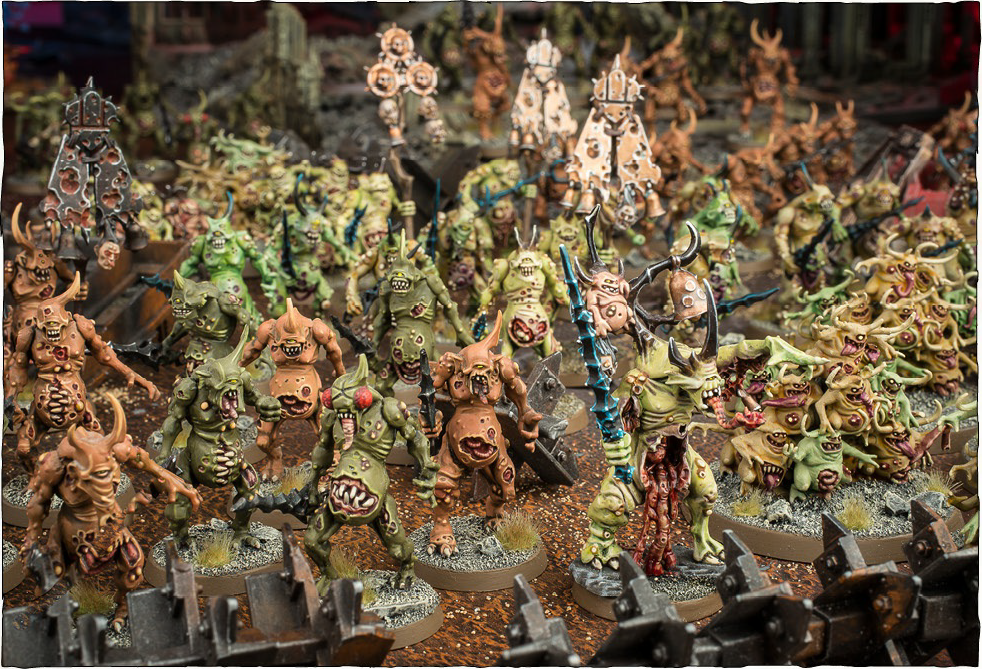
The suppurating Daemons of the Tallyband trudge into battle, surrounded by the drone of a billion flies. A squelching flood of Nurglings spills across the battlefield at the host's fore, giggling and squealing as they nip and scratch the enemy. Behind these stench-ridden hell-mites shamble rank upon rank of dour Plaguebearers, their incessant counting interspersed with fatalistic grumbles and the odd phlegmy retch. The stink of the Tallyband is a weapon in its own right, a metaphysical foulness that seeps through every barrier to leave its victims weak and nauseated. Worse are the swirling clouds of flies that swarm blizzard-thick around the Daemons, blanketing the enemy in the crawling horror of their rot-fat bodies until they can barely fight back against the muttering killers in their midst.
Restrictions: None.
Distracting Swarm of Flies: Enemy units cannot fire Overwatch against units from a Tallyband.
Enfeebling Nausea: At the start of each Assault phase, enemy units that are locked in combat with any units from a Tallyband must pass a Leadership test or reduce their Strength and Toughness characteristics by 1 for the duration of that phase.
Harbinger of Nurgle: If the Herald of Nurgle from this Formation is a Lesser Locus of Virulence, Greater Locus of Fecundity or an Exalted Locus of Contagion, the special rules associated with that locus affect all units from this Formation that are within 12" of him. If such a unit is also affected by another locus, they will receive both benefits.
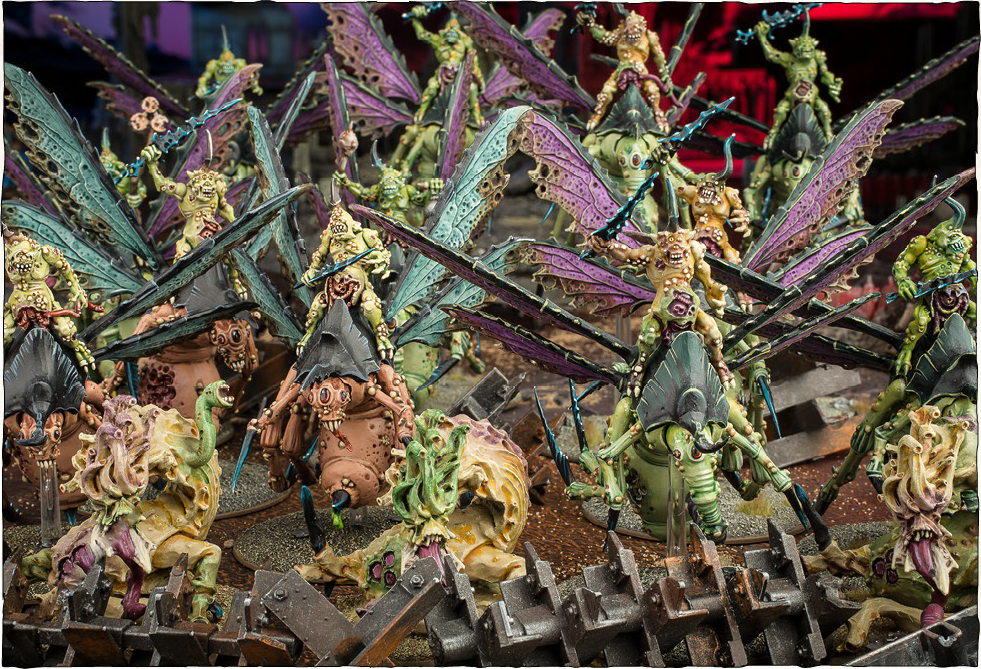
Bounding and buzzing, flopping and flapping, the bestial Daemons of Nurgle lurch awkwardly to war. They are herded by a Herald of Nurgle bearing the dubious title of Mouldsire of the Rotswarm, whose task is far from an enviable one. While they can impale a man with every proboscis stab, Plague Drones are spiteful, wilful Daemons that wish only to hurt other living things. The Beasts of Nurgle are all but impossible to herd, being lolloping simpletons whose joy at the sight of new playmates deafens them to even the most desperately bellowed commands. Despite these challenges, when the Mouldsire succeeds in herding the Rotswarm into the enemy's ranks the Daemons become a foul wall of corrosive slime and crushing bodies that swiftly reduces its victims to bubbling corpse-sludge.
Restrictions: None.
Harbinger of Nurgle: If the Herald of Nurgle from this Formation is a Lesser Locus of Virulence, Greater Locus of Fecundity or an Exalted Locus of Contagion, the special rules associated with that locus affect all units from this Formation that are within 12" of him. If such a unit is also affected by another locus, they will receive both benefits.
Corrosive Slime: All units in a Rotswarm have the Hammer of Wrath special rule, and these attacks have the Poisoned (4+) special rule.
Dubious Command: At the start of each of the controlling player's Assault phases, the Herald of Nurgle from a Rotswarm can attempt to direct a single unit from his Formation that is within 12" of him. To do so, he must take a Leadership test. If the test is passed, the directed unit can re-roll failed charge rolls and all models in the unit can make 3 additional Attacks until the end of the turn; if the test is failed, the directed unit must attempt to charge the nearest enemy unit in this Charge subphase, but is otherwise unaffected.
Those slain by a Daemon crowned with the fabled Horn of Nurgle's Rot are doomed to rise once more, their altered corpse joining the shambling ranks of Nurgle's tallymen.
After resolving the bearer's close combat attacks, add 1 model to a friendly unit of Plaguebearers of Nurgle within 12" of the bearer for each enemy model that was slain. The model must be placed within unit coherency, more than 1" from any enemy models. Any models that cannot be placed in this manner are lost.
Daemon Prince of Nurgle or Herald of Nurgle only.
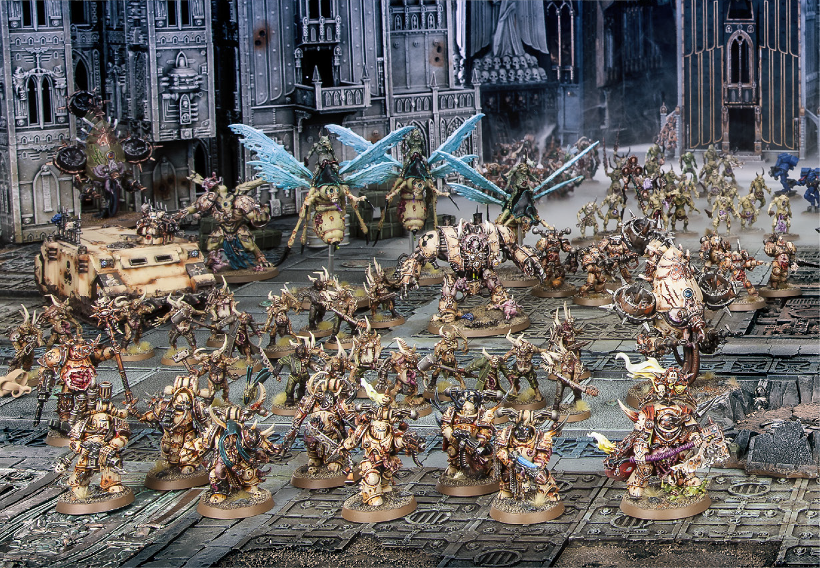
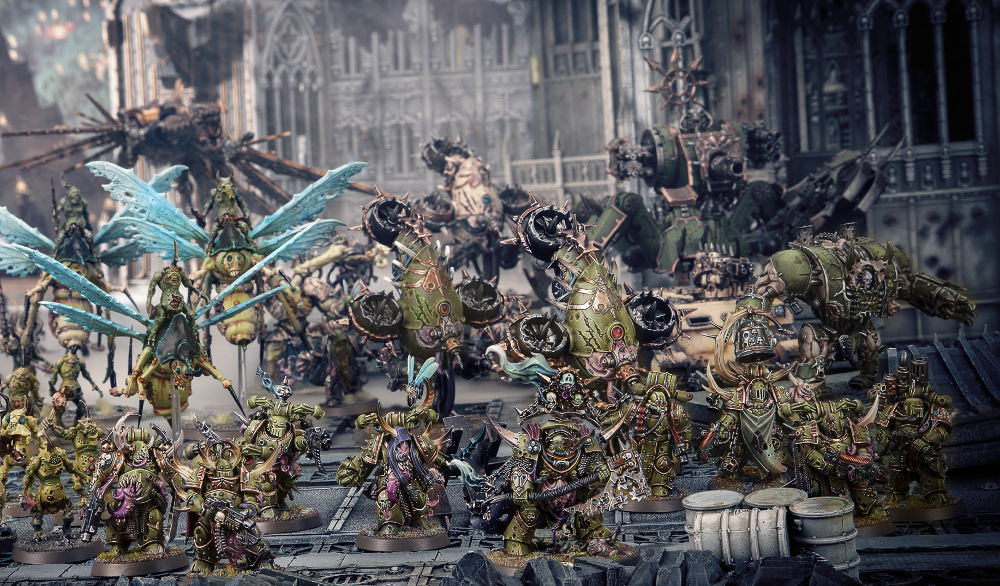
Amongst a stinking miasma of infectious gases, the legions of Nurgle advance with slow but unstoppable momentum. The air fills with the drone of bloated flies and chanting Plaguebearers, their vile chorus punctuated by the crash and roar of gunfire.
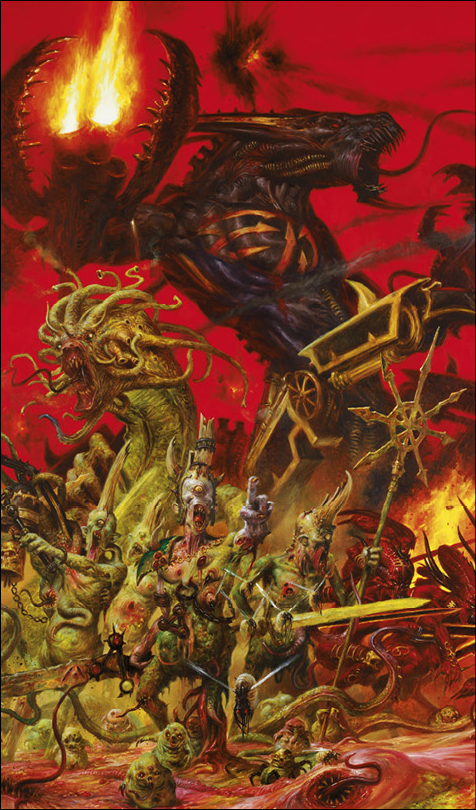
| Khorne | Tzeentch | Nurgle | Slaanesh | |
|---|---|---|---|---|
| Greater Daemons | Bloodthirsters Fists of Khorne Guardians of the Throne Blooded Ones |
Lords of Change The Eyes of Tzeentch The Feathered Lords The Watching |
Great Unclean Ones Plague Lords Fly Masters Stench Lords |
Keepers of Secrets Slayers of Slaanesh Feasters of Pain Despoilers of the Flesh |
| Heralds | Heralds of Khorne Skulltaker |
Heralds of Tzeentch The Changeling |
Heralds of Nurgle Epidemius |
Heralds of Slaanesh The Masque |
| Lesser Daemons | Bloodletters Khorne's Chosen Teeth of Death Takers of Skulls |
Pink Horrors Whirling Destroyers Squealers Blue Horrors Spinning Sourguts Grumblers Brimstone Horrors |
Plaguebearers Maggotkin Nurgle's Tallymen Nurglings Pus Spores Mites of Nurgle |
Daemonettes Children of Slaanesh Bringers of Joyous Degradation Seekers of Decadence |
| Daemonic Beasts | Flesh Hounds Hunters of Blood Flesh-Renders Juggernauts of Khorne Soul Crushers |
Flamers of Tzeentch Burning Horrors Fire Daemons Screamers Sky-sharks of Tzeentch Discs of Tzeentch |
Beasts of Nurgle Slime Hounds Nurgle's Lapdogs |
Fiends of Slaanesh Bestials Unholy Ones Steeds of Slaanesh Tongue Lashers Degraded Ones |
| Daemon Princes Soul Grinders Furies Skarbrand | ||||
The sky darkens with noxious clouds and the land sickens and withers as the Daemons of Nurgle lumber into battle. Unnatural plagues billow about them. Slime and toxins drip from their blades and claws. Warped bells toll and bloated flies buzz, filling the air with a droning din as the hideous slaughter begins...
Nurgle's Daemons spill into realspace in thronging masses, surrounded by swirling clouds of bloated plague flies. The endless droning of these insects provides a fitting accompaniment to the constant muttering of thousands of Plaguebearers, as they attempt to catalogue the full breadth of the Lord of Decay's manifold concoctions. Unhurried and uncaring of the enemy fire that splatters off their corpulent forms, they march towards the foe with implacable menace. Cackling Nurglings caper about the ankles of their larger fellows - once battle is joined these diminutive Daemons spill over the enemy in an irrepressible tide, giggling and chortling to each other as they bite and scratch at mortal flesh, before dribbling their infectious toxins into open wounds. Grossly malformed creatures covered in caustic slime and rippling with virulent poxes, Beasts of Nurgle bound playfully alongside the plague-ridden Tallybands, while Plague Drones wheel overhead, mounted upon their monstrous Rot Flies. In the midst of this poxridden tide lumbers the colossal, bloated bulk of a Great Unclean One, its flyblown, pus-dripping body an embodiment of the Plague God's fearsome constitution. The slug-like tongue of this Greater Daemon lolls from its gaping maw as it chortles in delight, urging its children onwards to spread Nurgle's bountiful maladies amongst the unenlightened masses.
[...]
A Nurgle Daemon infestation often begins with a single, luckless victim becoming infected with a mysterious ailment. The exact horrors wrought upon the bearer's body differ depending on the strain that was contracted, but in all cases the results are as excruciating as they are deadly. Every cough and pus-choked scream sends clouds of Daemon-spores swirling into the air. With horrifying speed the disease begins to spread amongst the populace, mutating and evolving into ever more horrific strains as it does so. Before long the streets are piled high with swollen corpses, and clouds of flies blot out the sun. It is then that the bells begin to toll, and the Tallybands of Nurgle erupt from the gasblown carcasses of the dead. Those ragged survivors still capable of bearing arms against these putrid invaders are swiftly overcome, and the least fortunate of all are taken alive for experimentation. Gleeful Nurglings chortle and applaud as these fresh subjects are dunked into foetid pools of caustic slime, or hurled the slavering maws of slime-covered beasts.
Even if they are driven from the battlefield with barrages and firestorms of promethium, the profane gifts of Nurgle's children still linger. These include the disease known as Nurgle's Rot, a slow-acting but utterly fatal malady that agonisingly transforms the victim into a Plaguebearer, as well as the many strains of the dreaded zombie plague. The latter is a particular favourite amongst followers of the Lord of Decay, especially the hated Death Guard warbands. There are countless variations of this disease. Some are delivered by skyburst mortars into the upper atmosphere, while others are poured into a planet's water reserves or summoned in a pestilential monsoon by a pox-sorcerer's ritual. The most common strain deployed by the Death Guard keeps its victims alive and coherent even as it agonisingly reshapes their flesh. They become the shambling, rotting monsters known as Poxwalkers, whose role it is to soak up enemy fire before the advance of the Heretic Astartes, spreading their hideous infection amongst the foe even as las-fire and explosions blast them apart in gouts of pus and gore. The victim's mortal soul is trapped within this horrifying shell, unable to act or do anything but scream and beg for the blissful release of obliteration.
![]()
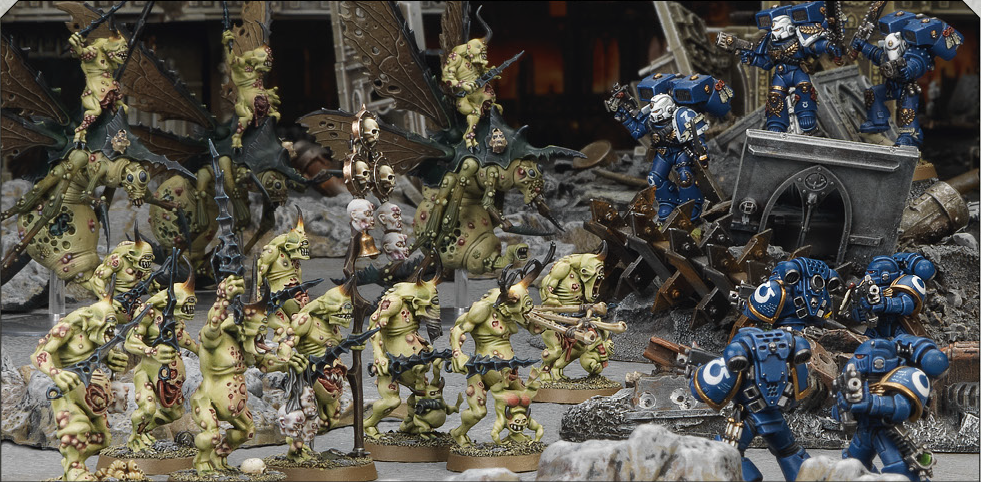
Plaguebearers spread lethal diseases in a dozen different ways, sombrely tallying their number and studying their effects.
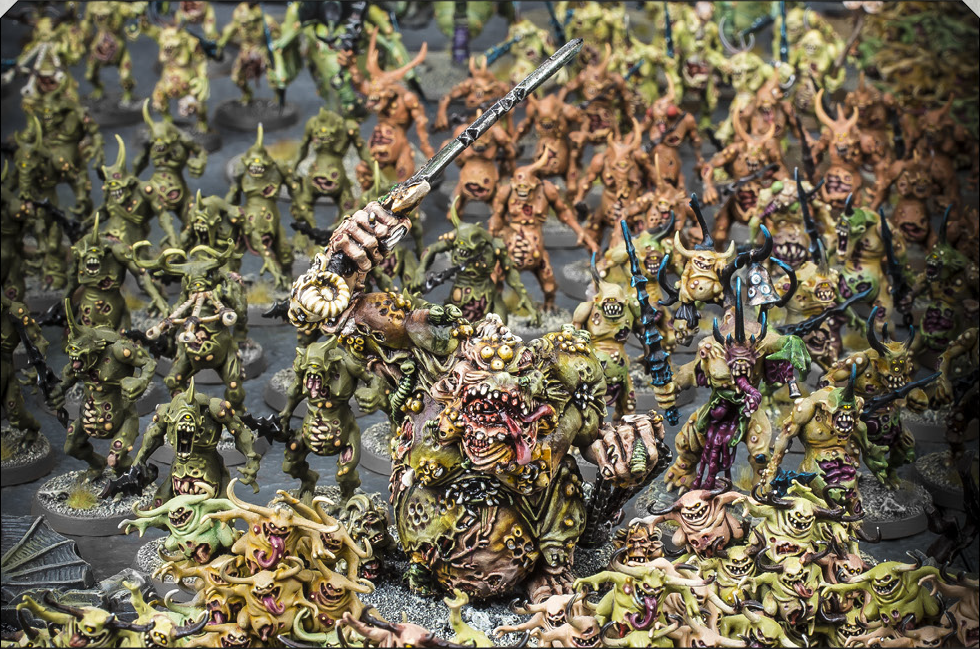
The putrescent hordes of Nurgle are led to battle by mountainous Great Unclean Ones, creatures strong enough to crush a tank.
The dull knell of bells and the humming of flies herald the arrival of Nurgle's Plaguebearers. Forming the rank and file of his pestilent legions, the Lesser Daemons of Nurgle shuffle forwards, their ripe bodies swollen with contagion and rife with the stench of decay. Each Daemon has a single rheumy eye and a horn sprouting from its skull - the mark of Nurgle's Rot that each bears through eternity.
It is the Plaguebearers' role to keep stock of new diseases and symptoms, and to maintain some semblance of order amongst Nurgle's naturally mischievous hordes. The Plaguebearers' obsessive need to organise is characterised by their constant counting as they try to calculate every new outbreak of plague. However, this monotonous chanting achieves very little - it is practically impossible to catalogue anything amidst the ever-changing nature of Chaos. This in no way discourages them, however, for they are the embodiment of the need to impose order upon a meaningless and uncaring world. In battle, their corpulent forms resist all but the most fearsome weaponry, and they wield rusted blades that corrupt flesh and rust metal in an instant. Unfortunately for the Plaguebearers, they are prone to losing count during combat, and they stand above their dying foes groaning in frustration before starting their count all over again.
Chief among the many gifts that the Lord of Plagues has granted an ungrateful galaxy is Nurgle's Rot. This perfect illness does not kill its host quickly; rather, it slowly turns the victim into a bloated living corpse teeming with the stuff of nightmares. Their blood curdles in their veins, their eyes grow together into a single globulous orb, and a horn sprouts from their head. The illness does not merely affect the body, however - it painfully corrupts the diseased mortal's soul to the point where the victim has to either end their own life or fully embrace the ways of Nurgle and become a Plaguebearer.
The longer an infected soul resists Nurgle's Rot, the more likely it is that they will survive the disgusting changes wrought upon them, and the more powerful a Plaguebearer they will become once the transformation is complete. Such individuals are sometimes possessed of a sheepish embarrassment that it took them so long to appreciate the blessings of their new existence. To one who has truly converted to Nurgle's cause, life as a bandy-legged mound of putrescent, boil-covered flesh and disgusting bodily functions is seen as the most fulsome of blessings rather than a despicable curse that will never end.
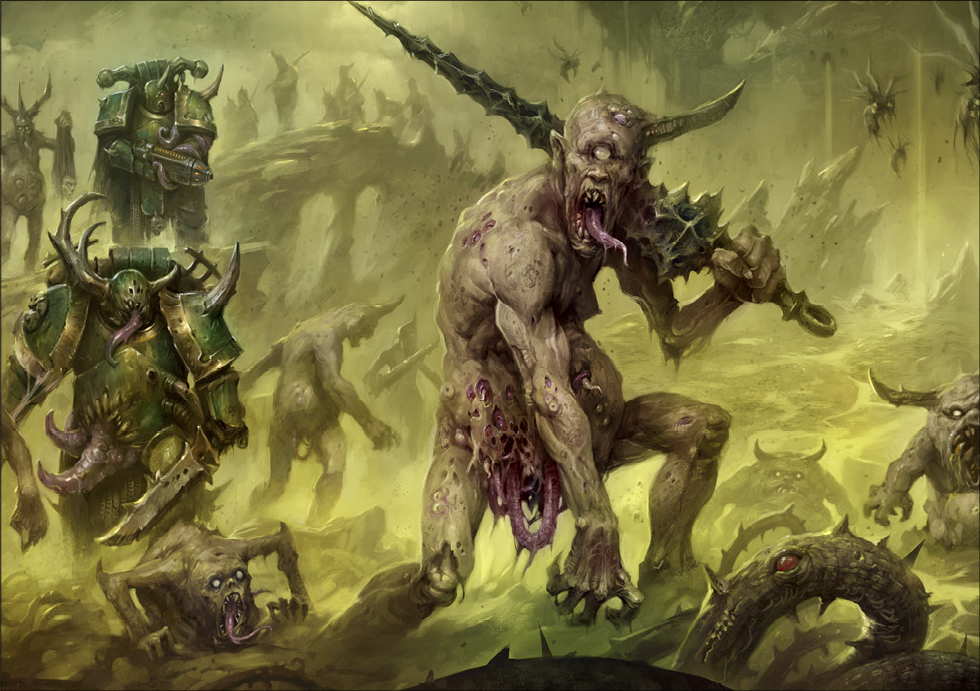
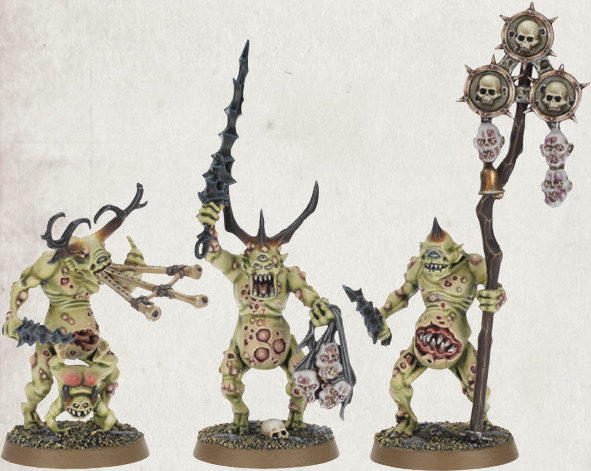
Plaguebearers
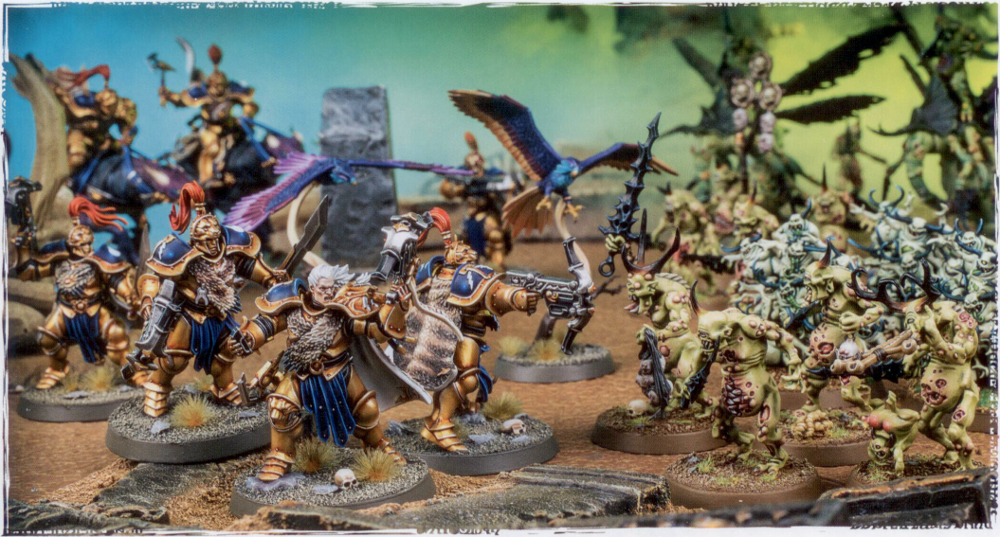
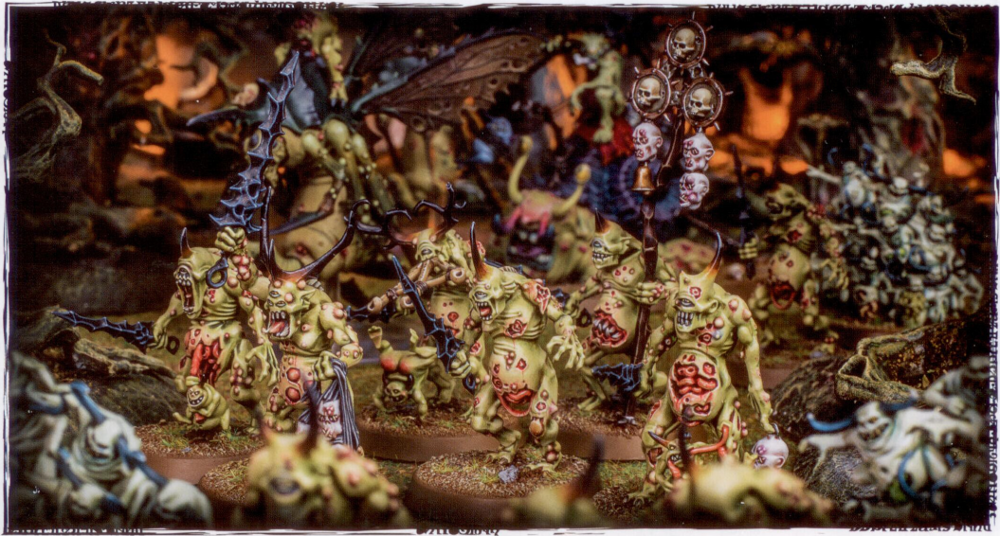
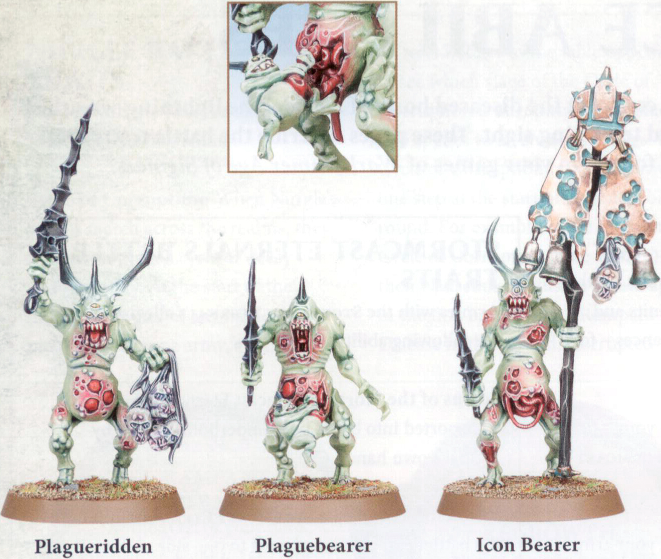
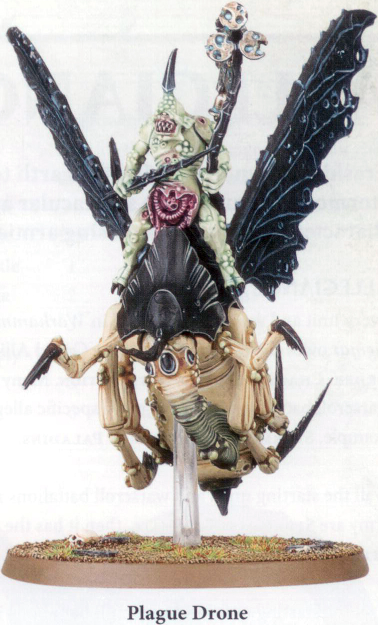
Plaguebearers trudge to battle amidst the drone of flies' wings and endless counting. These corpse-like daemons tally the diseases unleashed by Nurgle upon the Mortal Realms, and as they do so they stab and hack at their enemies with filth-ridden plagueswords. Relentless and resilient in equal measures, Plaguebearers overwhelm their victims as surely as a terminal sickness.
| Move | Wounds | Save | Bravery |
|---|---|---|---|
| 4" | 1 | 5+ | 10 |
| Melee Weapons | Range | Attacks | To Hit | To Wound | Rend | Damage |
|---|---|---|---|---|---|---|
| Plaguesword | 1" | 1 | 4+ | 3+ | - | 1 |
A unit of Plaguebearers of Nurgle has 10 or more models. They are armed with vile Plagueswords.
The leader of this unit is the Plagueridden. A Plagueridden makes 2 attacks rather than 1.
Models in this unit may be Icon Bearers. If you roll a 1 when making a battleshock test for a unit that includes any Icon Bearers, reality blinks and the daemonic horde is bolstered. Add D6 Plaguebearers to the unit.
Models in this unit can be Pipers. Your opponent must re-roll battleshock tests of 1 for units that are within 6" of any Pipers.
Cloud of Flies: Plaguebearers attract great clouds of flies that buzz about them, obscuring them from view. Your opponent must subtract 1 from any hit rolls made in the shooting phase that target a unit of Plaguebearers. If this unit contains 20 or more models, your opponent must instead subtract 2 from these hit rolls, as well as subtracting 1 from any hit rolls that target it in the combat phase.
Disgustingly Resilient: Roll a dice each time this unit suffers a wound or mortal wound; on a 5 or more, the wound sloughs away rancid flesh but does no real harm and is ignored.
Locus of Fecundity: You can re-roll save rolls of 1 for this unit if it is within 7" of any Daemon Heroes of Nurgle from your army.
Chaos Wizards know the Summon Plaguebearers spell, in addition to any others they know.
Summon Plaguebearers has a casting value of 6. If successfully cast, you can set up a unit of up to 10 Plaguebearers within 14" of the caster and more than 9" from any enemy models. The unit is added to your army but cannot move in the following movement phase. If the result of the casting roll was 11 or more, set up a unit of up to 20 Plaguebearers instead.
Chaos, Daemon, Nurgle, Plaguebearers
Amongst the swiftest and most dangerous of Nurgle's followers, Plague Drones are high-ranking Plaguebearers who ride to war astride huge and malevolent Rot Flies. These daemonic airborne mounts attack the foe with stingers, proboscises and chitinous limbs, while their riders hurl slime-filled death's heads into the enemy lines that explode in showers of infectious filth.
| Move | Wounds | Save | Bravery |
|---|---|---|---|
| 8" | 5 | 5+ | 10 |
| Missile Weapons | Range | Attacks | To Hit | To Wound | Rend | Damage |
|---|---|---|---|---|---|---|
| Death's Head | 14" | 1 | 4+ | 3+ | - | 1 |
| Melee Weapons | Range | Attacks | To Hit | To Wound | Rend | Damage |
| Plaguesword | 1" | 1 | 4+ | 3+ | - | 1 |
| Prehensile Proboscis | 1" | 3 | 3+ | 4+ | - | 1 |
| Venomous Sting | 1" | 1 | 4+ | 3+ | -1 | D3 |
A unit of Plague Drones of Nurgle has 3 or more models. The Rot Flies attack with their Prehensile Proboscises and Venomous Stings, while their Plaguebearer riders swing Plagueswords and throw virulent Death's Heads.
Plague Drones can fly.
The leader of this unit is the Plaguebringer. A Plaguebringer makes 2 attacks rather than 1 with its Plaguesword.
Models in this unit may be Icon Bearers. If you roll a 1 when taking a battleshock test for a unit that includes any Icon Bearers, reality blinks and the daemonic horde is bolstered. Add D3 Plague Drones to the unit.
Models in this unit can be Bell Tollers. Your opponent must re-roll battleshock tests of 1 for units that are within 6" of any Bell Tollers.
Disgustingly Resilient: Roll a dice each time this unit suffers a wound or mortal wound; on a 5 or more, the wound sloughs away rancid flesh but does no real harm and is ignored.
Locus of Contagion: If the result of a wound roll made for this unit is a 6 or more, and this unit is within 7" of a Daemon Hero of Nurgle from your army, that wound turns septic and flyblown in moments, inflicting a mortal wound on the target unit in addition to any other damage.
Chaos Wizards know the Summon Plague Drones spell, in addition to any others they know.
Summon Plague Drones has a casting value of 6. If successfully cast, you can set up a unit of up to 3 Plague Drones within 14" of the caster and more than 9" from any enemy models. The unit is added to your army but cannot move in the following movement phase. If the result of the casting roll was 11 or more, set up a unit of up to 6 Plague Drones instead.
Chaos, Daemon, Plaguebearer, Nurgle, Plague Drones
The dull knell of bells and the humming of flies herald the arrival of Nurgle's Plaguebearers, the rank-and-file of the Plague Legions. Each Plaguebearer is formed from the corrupted soul of a mortal that contracted Nurgle's Rot. The longer a victim endures against the soul-gnawing disease - which varies in virulence - the greater the boon of power granted by the Lord of Decay. The Daemon shuffles forwards, its ripe body swollen and bursting open with contagion. The stench of unnatural decay hangs heavy, surrounding the Plaguebearer like a fug. Each Daemon has a single rheumy eye and a horn sprouting from its skull - the mark of Nurgle's Rot that each bears through eternity. What little flesh it has remaining is stretched over ruptured organs and marked with innumerable sores and dripping cysts.
It is the Plaguebearers' role to keep stock of new diseases, and to maintain some semblance of order amongst Nurgle's naturally mischievous hordes. The Plaguebearers' obsessive need to organise is characterised by their constant counting as they try to calculate every new outbreak of plague, an onerous duty that they carry out begrudgingly. In truth, their monotonous chanting achieves very little save for making mortals feel nauseous - it is practically impossible to catalogue anything amidst the ever-changing nature of Chaos. This in no way discourages them, however, for they are the embodiment of the need to impose order upon a meaningless and uncaring world. Unfortunately for the Plaguebearers, they are prone to losing count during the back-and-forth mayhem of combat, and the glum Daemons groan in frustration before starting their count all over again. Such sights rarely escape the eye of any nearby Spoilpox Scriveners, who are eager to punish any they can for their failings.
In battle, Plaguebearers shamble purposefully towards their foes. Packs of these Lesser Daemons - often up to seven of them - are known as the Tallybands, and form the core of many of Nurgle's Plague Legions. Each Plaguebearer wields a rusted blade that corrupts flesh in an instant. Should a foe endure the stench and not be struck down, they will find their own blows hampered by swarming flies.When strikes do land upon Plaguebearers they seem to have little effect, for the minions of Nurgle feel no pain, and shrug off what should be lethal strokes.
High-ranking Plaguebearers are known amongst Nurgle's legions as Plague Drones, a title that conveys commendable humility. These overseers of Nurgle's realm ride into realspace mounted upon Rot Flies - colossal daemonic insects whose appearance is so repugnant it scars the mind. From their lofty positions, the Plague Drones can properly tally the diseases running rife across the battlefield, as well as swiftly intervene should Nurgle's divine plans meet with heavily armed resistance.
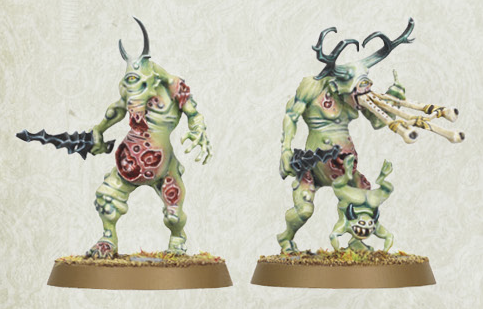
Plaguebearers of Nurgle
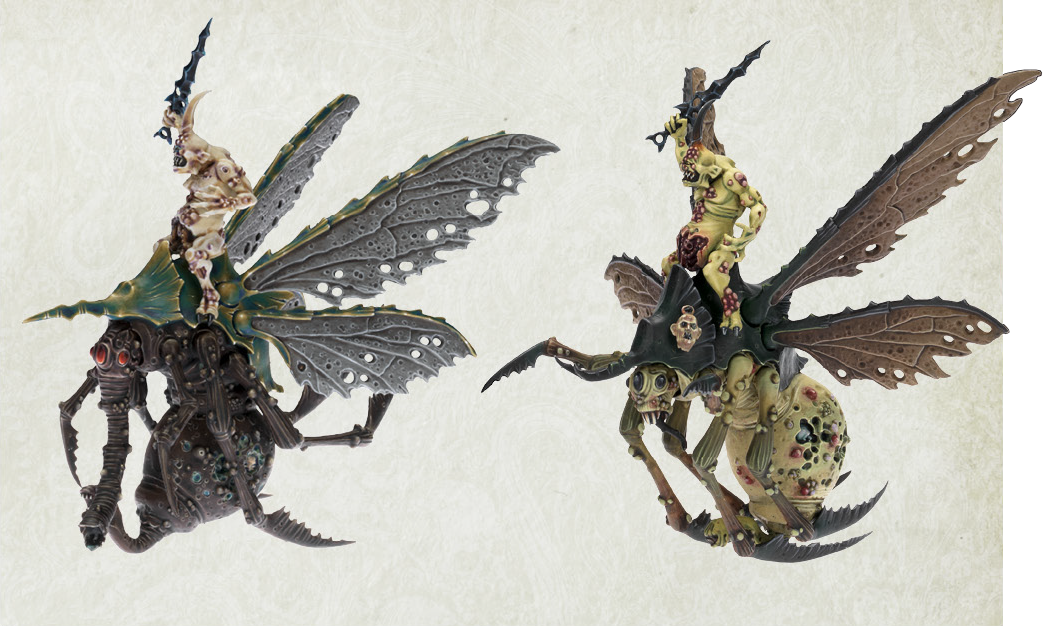
The cavalry known as Plague Drones are formed of Plaguebearers mounted upon Rot Flies. The colouration of both rider and mount often reflects a particular stage of Nurgle's cycle of decay and regeneration.
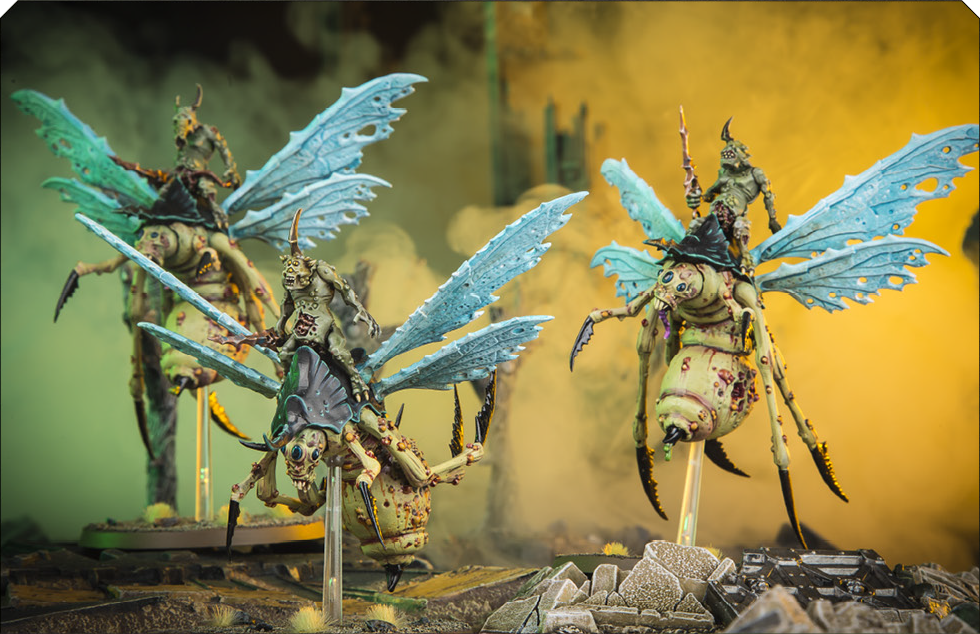
With a sickening buzz, the Plague Drones of Nurgle drop out of the skies to begin an assault.